Documents
U.S. SOCOM Procurement Document Announcing Desire to Utilize Deepfakes
Mar. 6 2023 — 12:23 p.m.
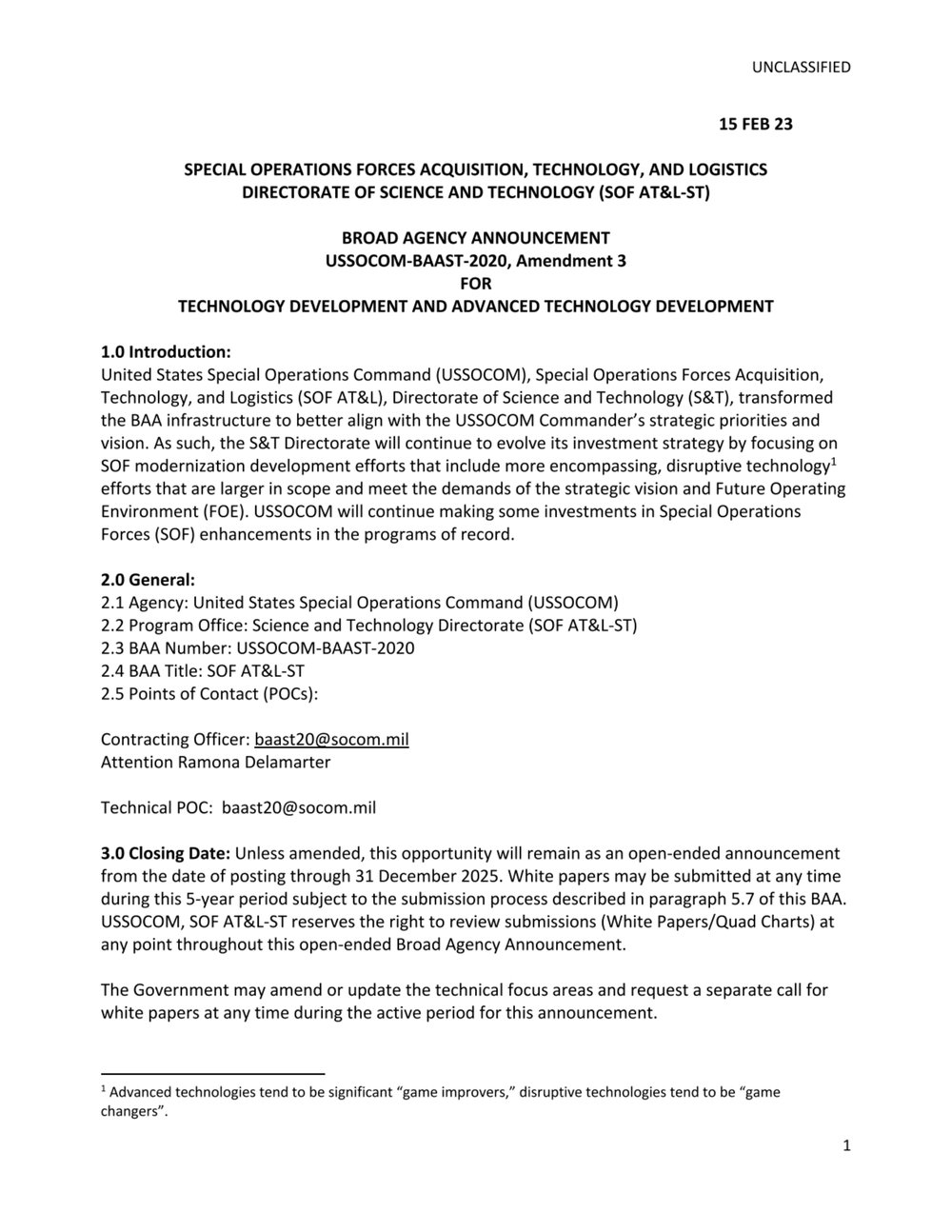
UNCLASSIFIED.
15FE823
SPECIAL OPERATIONS FORCES ACQUISITION, TECHNOLOGY, AND LOGISTICS
DIRECTORATE OF SCIENCE AND TECHNOLOGY (SOF AT&L-ST)
BROAD AGENCY ANNOUNCEMENT
USSOCOM-BAAST-2020, Amendment 3
FOR
TECHNOLOGY DEVELOPMENT AND ADVANCED TECHNOLOGY DEVELOPMENT
1.0 Introduction:
United States Special Operations Command (USSOCOM), Special Operations Forces Acquisition,
Technology, and Logistics (SOF ATL), Directorate of Science and Technology (S&T), transformed
the BAA infrastructure to better align with the USSOCOM Commander's strategic priorities and
vision. As such, the S&T Directorate will continue to evolve its investment strategy by focusing on
SOF modernization development efforts that include more encompassing, disruptive technology®
efforts that are larger in scope and meet the demands of the strategic vision and Future Operating,
Environment (FOE). USSOCOM will continue making some investments in Special Operations
Forces (SOF) enhancements in the programs of record.
2.0 General:
2.1 Agency: United States Special Operations Command (USSOCOM)
2.2 Program Office: Science and Technology Directorate (SOF ATAL-ST)
2.3 BAA Number: USSOCOM-BAAST-2020
2.4 BAA Title: SOF ATALST
2.5 Points of Contact (POCs):
Contracting Officer: baast20@socom.mil
Attention Ramona Delamarter
Technical POC: baast20@socom.mil
3.0 Closing Date: Unless amended, this opportunity will remain as an open-ended announcement
from the date of posting through 31 December 2025. White papers may be submitted at any time
during this 5-year period subject to the submission process described in paragraph 5.7 of this BAA
USSOCOM, SOF AT&L-ST reserves the right to review submissions (White Papers/Quad Charts) at
any point throughout this open-ended Broad Agency Announcement.
The Government may amend or update the technical focus areas and request a separate call for
‘white papers at any time during the active period for this announcement.
* Advanced technologies tend tobe significant “game improves,” disruptive technologies tend to be ‘game
changers
1
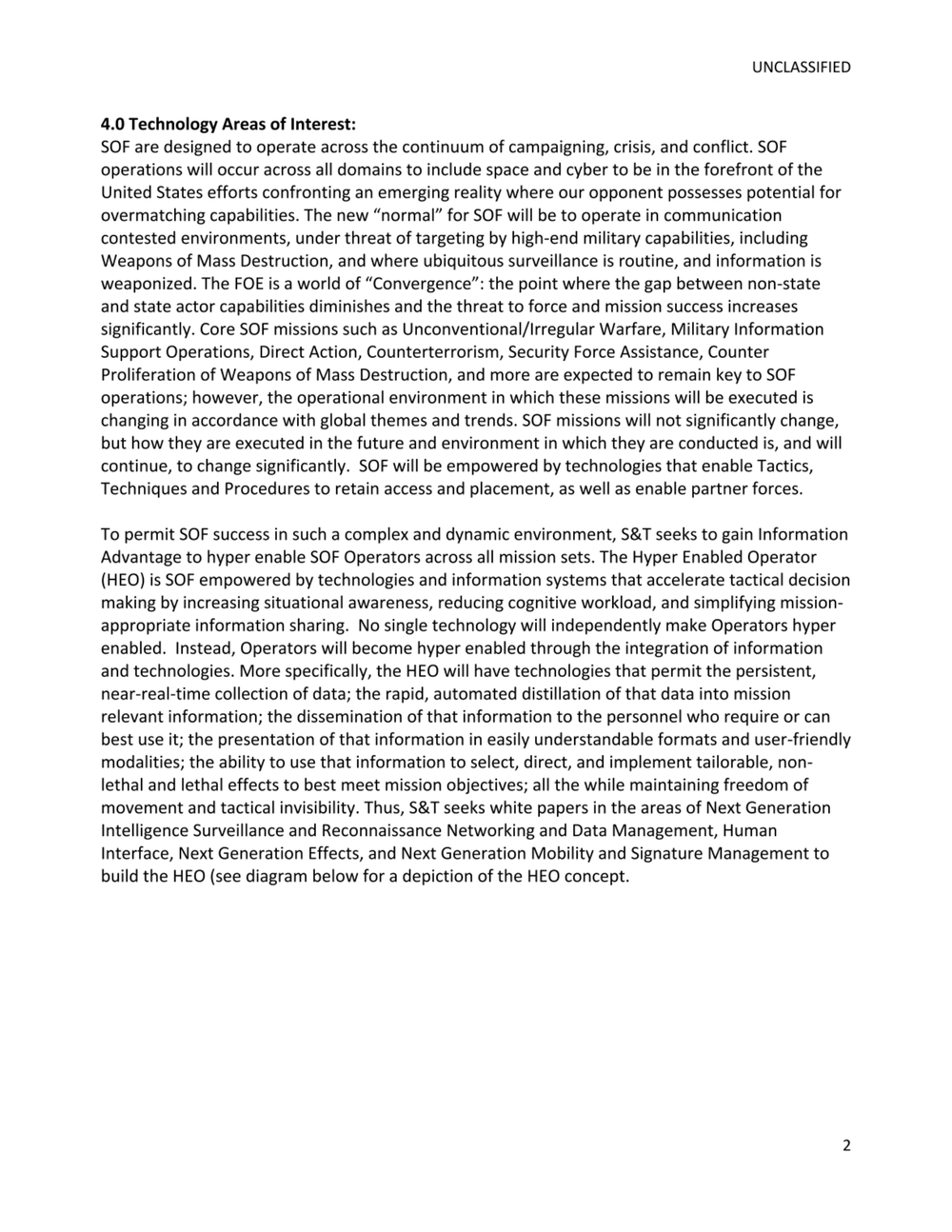
UNCLASSIFIED.
4.0 Technology Areas of Interest:
SOF are designed to operate across the continuum of campaigning, crisis, and conflict. SOF
‘operations will occur across all domains to include space and cyber to be in the forefront of the
United States efforts confronting an emerging reality where our opponent possesses potential for
‘overmatching capabilities. The new “normal” for SOF wil be to operate in communication
contested environments, under threat of targeting by high-end military capabilities, including
‘Weapons of Mass Destruction, and where ubiquitous surveillance is routine, and information is
weaponized. The FOE is a world of “Convergence”: the point where the gap between non-state
and state actor capabilities diminishes and the threat to force and mission success increases
significantly. Core SOF missions such as Unconventional/Irregular Warfare, Miltary Information
Support Operations, Direct Action, Counterterrorism, Security Force Assistance, Counter
Proliferation of Weapons of Mass Destruction, and more are expected to remain key to SOF
‘operations; however, the operational environment in which these missions will be executed is
changing in accordance with global themes and trends. SOF missions will not significantly change,
but how they are executed in the future and environment in which they are conducted is, and will
continue, to change significantly. SOF will be empowered by technologies that enable Tactics,
Techniques and Procedures to retain access and placement, as well as enable partner forces.
To permit SOF success in such a complex and dynamic environment, S&T seeks to gain Information
Advantage to hyper enable SOF Operators across all mission sets. The Hyper Enabled Operator
(HEO) is SOF empowered by technologies and information systems that accelerate tactical decision
making by increasing situational awareness, reducing cognitive workload, and simplifying mission-
appropriate information sharing. No single technology will independently make Operators hyper
enabled. Instead, Operators will become hyper enabled through the integration of information
and technologies. More specifically, the HEO will have technologies that permit the persistent,
near-real-time collection of data; the rapid, automated distillation of that data into mission
relevant information; the dissemination of that information to the personnel who require or can
best use it; the presentation of that information in easily understandable formats and user-friendly
modalities; the ability to use that information to select, direct, and implement tailorable, non-
lethal and lethal effects to best meet mission objectives; all the while maintaining freedom of
movement and tactical invisibility. Thus, S&T seeks white papers in the areas of Next Generation
Intelligence Surveillance and Reconnaissance Networking and Data Management, Human
Interface, Next Generation Effects, and Next Generation Mobility and Signature Management to
build the HEO (see diagram below for a depiction of the HEO concept.
2
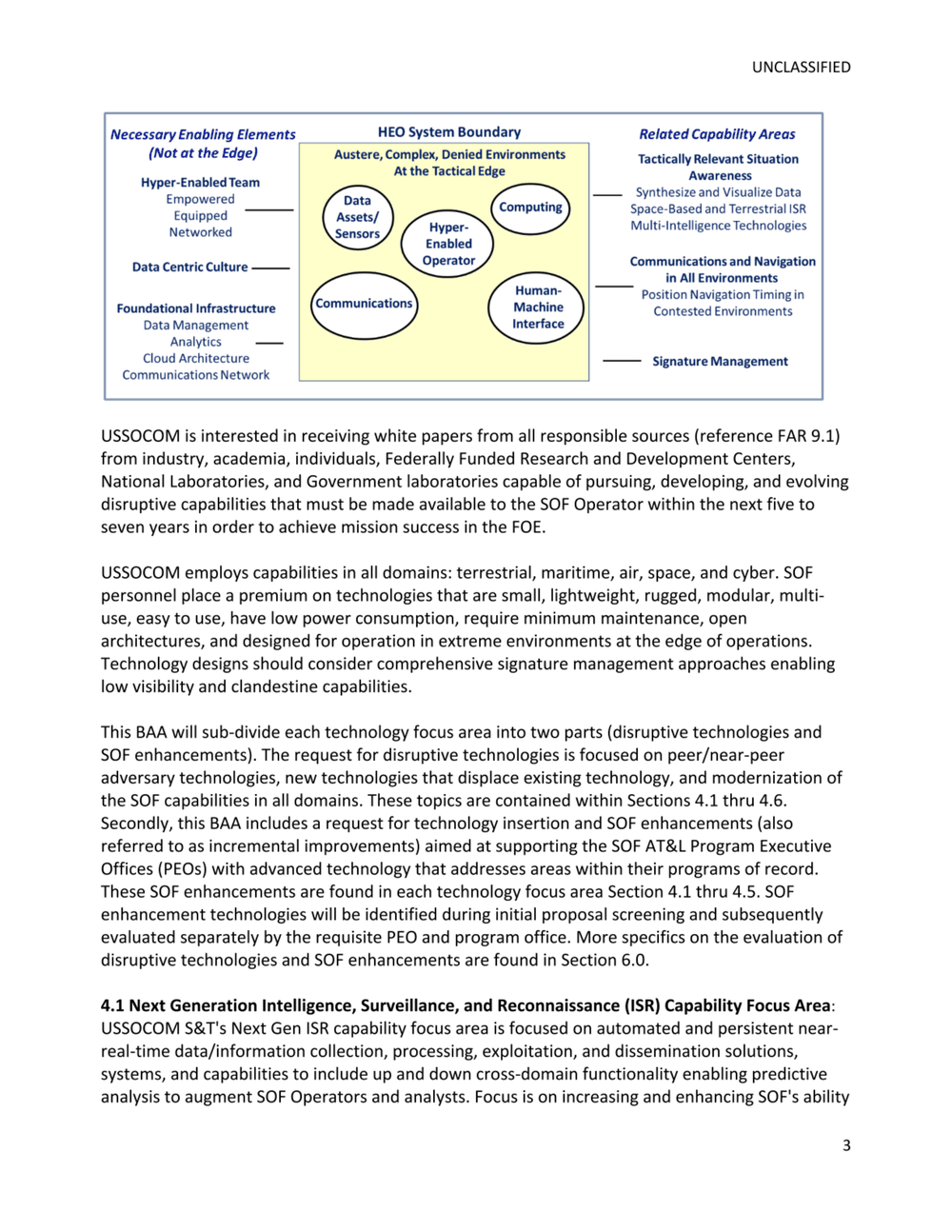
ER, veo spremsomany rect comets
rere | Ros tonpe bones | emer
Hyper-Enabled Team AinTatialbige avanm
mowed | we ee
Lares, Le Meter Teepe:
sconce conmmenmmavatgion
Em
S— in
i Bo ieren
USSOCOM is interested in receiving white papers from all responsible sources (reference FAR 9.1)
from industry, academia, individuals, Federally Funded Research and Development Centers,
National Laboratories, and Government laboratories capable of pursing, developing, and vohing
disruptive capabilities that must be made available to the SOF Operator within the next five to
seven years in order to achieve mission success in the FOE.
USSOCOM employs capabilities in all domains: terrestrial, maritime, air, space, and cyber. SOF
use, easy to use, have low power consumption, require minimum maintenance, open
architectures, and designed for operation in extreme environments at the edge of operations.
This BAA will sub-divide each technology focus area into two parts (disruptive technologies and
SOF enhancements). The request for disruptive technologies is focused on peer/near-peer
adversary technologies, new technologies that displace existing technology, and modernization of
‘the SOF capabilities in all domains. These topics are contained within Sections 4.1 thru 4.6.
Secondly, this BAA includes a request for technology insertion and SOF enhancements (also
referred to as incremental improvements) aimed at supporting the SOF AT&L Program Executive
Office (PEOS) with advanced technlogy hat actress areas within thei programs of record
These SOF enhancements are found in each technology focus area Section 4.1 thru 4.5. SOF
‘enhancement technologies will be identified during initial proposal screening and subsequently
evaluated separately by the requisite PEO and program office. More specifics on the evaluation of
disruptive technologies and SOF enhancements are found in Section 6.0.
4.1 Next Generation Intelligence, Surveillance, and Reconnaissance (ISR) Capability Focus Area:
USSOCOM S&T's Next Gen ISR capability focus area is focused on automated and persistent near-
real-time data/information collection, processing, exploitation, and dissemination solutions,
systems, and capabilities to include up and down cross-domain functionality enabling predictive
analysis to augment SOF Operators and analysts. Focus is on increasing and enhancing SOF's ability
5

UNCLASSIFIED.
to manage and understand threats and the environment, process multiple data and
‘communications inputs for optimized decision making, and support rapid, on-the-move ability to
learn and communicate knowledge across a mission stakeholder team to search, locate and
process High Value Targets.
SOF are interested in technologies that measure the physical characteristics of a given field of
view, day and night, and in all weather conditions. Mission elements that could be enhanced
include situational awareness, general planning, route planning, terrain mapping (including
subterranean/urban/interior), change detection, event forensics, facial recognition, and locating.
objects under vegetation as a few examples.
4.1.1 Next Generation ISR Disruptive Technology Areas Include:
4.1.1.1 Autonomy-Enabled ISR/Battlefield Situational Awareness (SA): Its difficult to achieve
persistent ISR without substantial manning and networking, computing, and software resources,
SOF are interested in automated detection, identification, and localization capabilites to support
SA of dismounted personnel. SOF require the ability to edge process, disseminate and query
information in operating environments unfavorable to the utilization of traditional networks and
‘computer servers. Bandwidth for information backhaul to computational centers and
infrastructures is not regularly available to small teams. SOF small teams lack sufficient personnel
to manually process, exploit and disseminate the amount of information generated by sensors
deployed throughout the world. SOF desire software applications optimized for computing at the
edge that automate the organization and fusion of data collected from multiple sources and
multiple intelligence disciplines with neural networks and machine learning to recognize patterns
and anomalies from various sensor types. SOF desire Augmented Reality (AR) enabling capabilities
that provide warfighters with visual cues to identify and discern targets, foes, and friendly forces.
SOF are also interested in reducing the cost of persistent AISR coverage by leveraging long
endurance platforms capable of staying in undersea, surface, air and space layers for weeks or
months at a time, as well a use of commercial capable ISR.
4.1.1.2 stand-off Sensor Detection and identification: SOF are in search of tactical physical,
behavioral, physiological, and/or electromagnetic signatures matching capability. System(s)
should quickly conduct tactical biometrics matching worldwide from a distance of 1 Km or more.
‘The system(s) need the ability to both store and upload data, operate both while stationary or
moving, and be capable of supporting both overt and clandestine operations. The systems should
employ advanced analytical software and sensor fusion designs to ingest multiple data inputs
including but not limited to irs, facial, anatomical measures, gestures, gait, heartbeat,
electromagnetic signals, deoxyribonucleic acid, and microbiome recognition. Software designs
should consider counter-countermeasures intended to mask one’s identity from automated
mechanisms. Software applications should have the ability to operate on smart phones. Other
‘options for stand-off biometrics include a distance up to 8 Ft with the ability to quickly ingest
physical, behavioral, physiological, and/or electromagnetic signatures the Operator can use to
measure response rates, provide a confidence factor, and assist in determining overall campaign
effectiveness. Software designs should consider non-intrusive, innovative concepts with
4
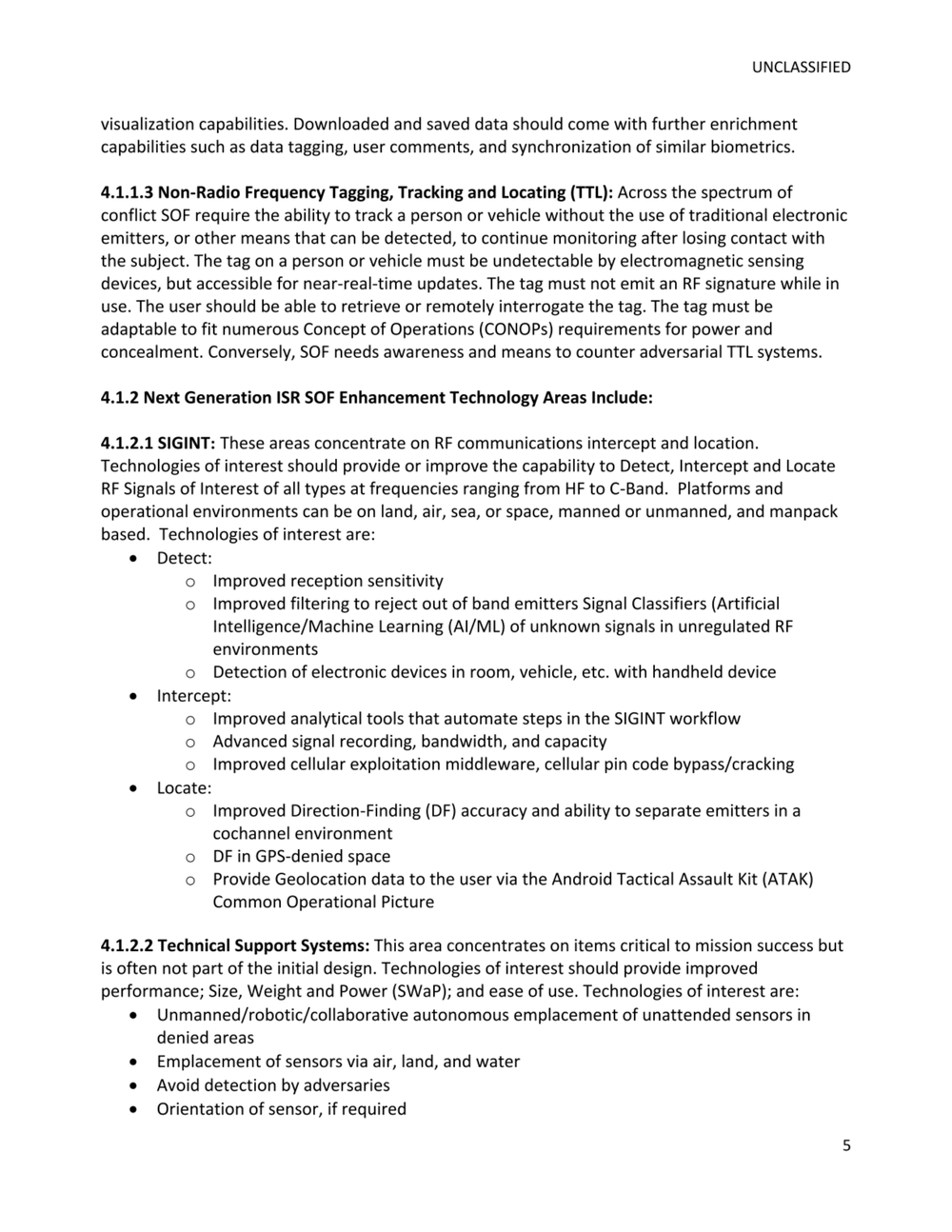
UNCLASSIFIED.
visualization capabilities. Downloaded and saved data should come with further enrichment
capabilities such as data tagging, user comments, and synchronization of similar biometrics.
4.1.1.3 Non-Radio Frequency Tagging, Tracking and Locating (TTL): Across the spectrum of
conflict SOF require the ability to track a person or vehicle without the use of traditional electronic
emitters, or other means that can be detected, to continue monitoring after losing contact with
the subject. The tag on a person or vehicle must be undetectable by electromagnetic sensing
devices, but accessible for near-real-time updates. The tag must not emit an RF signature while in
use. The user should be able to retrieve or remotely interrogate the tag. The tag must be
adaptable to fit numerous Concept of Operations (CONOPs) requirements for power and
concealment. Conversely, SOF needs awareness and means to counter adversarial TTL systems.
4.1.2 Next Generation ISR SOF Enhancement Technology Areas Include:
4.1.2.1 SIGINT: These areas concentrate on RF communications intercept and location.
Technologies of interest should provide or improve the capability to Detect, Intercept and Locate
RF Signals of Interest of all types at frequencies ranging from HF to C-Band. Platforms and
‘operational environments can be on land, ai, sea, or space, manned or unmanned, and manpack
based. Technologies of interest are:
«Detect
© Improved reception sensitivity
© Improved filtering to reject out of band emitters Signal Classifiers (Artificial
Intelligence/Machine Learning (Al/ML) of unknown signals in unregulated RF
environments
© Detection of electronic devices in room, vehicle, etc. with handheld device
«Intercept
© Improved analytical tools that automate steps in the SIGINT workflow.
© Advanced signal recording, bandwidth, and capacity
© Improved cellular exploitation middleware, celular pin code bypass/cracking
Locate:
© Improved Direction-Finding (DF) accuracy and ability to separate emitters in a
cochannel environment
© DFin GPs-denied space
o Provide Geolocation data to the user via the Android Tactical Assault Kit (ATAK)
Common Operational Picture
4.1.2.2 Technical Support Systems: This area concentrates on items critical to mission success but
is often not part of the initial design. Technologies of interest should provide improved
performance; Size, Weight and Power (SWaP); and ease of use. Technologies of interest are:
« Unmanned/robotic/collaborative autonomous emplacement of unattended sensors in
denied areas
«Emplacement of sensors via air, land, and water
«Avoid detection by adversaries
«Orientation of sensor, if required
5
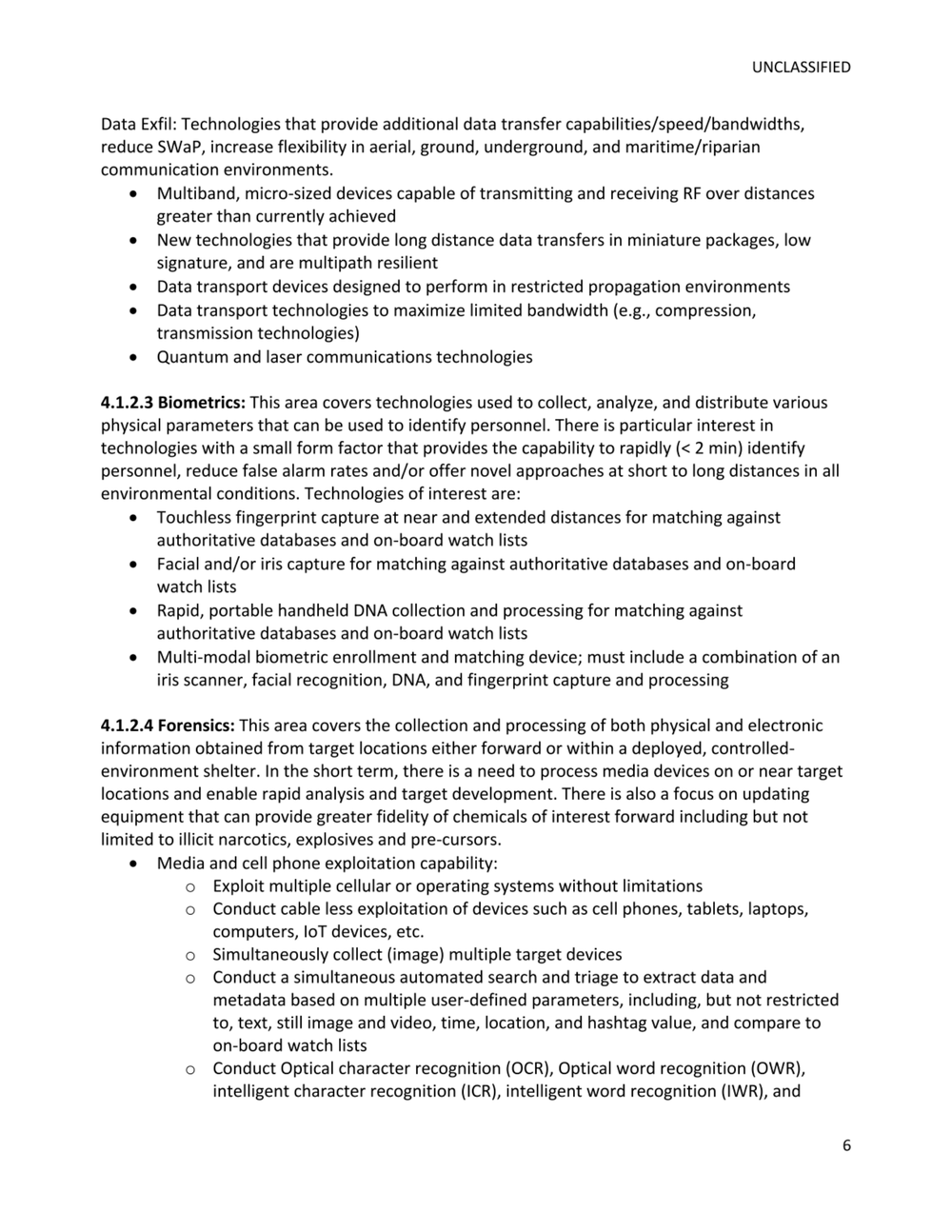
UNCLASSIFIED.
Data Exfil: Technologies that provide additional data transfer capabilities/speed/bandwidths,
reduce SWaP, increase flexibility in aerial, ground, underground, and maritime riparian
‘communication environments.
«Multiband, micro-sized devices capable of transmitting and receiving RF over distances
greater than currently achieved
«New technologies that provide long distance data transfers in miniature packages, low
signature, and are multipath resilient
«Data transport devices designed to perform in restricted propagation environments
«Data transport technologies to maximize limited bandwidth (e.g., compression,
transmission technologies)
Quantum and laser communications technologies
4.1.2.3 Biometrics: This area covers technologies used to collect, analyze, and distribute various
physical parameters that can be used to identify personnel. There is particular interest in
technologies with a small form factor that provides the capability to rapidly (< 2 min) identify
personnel, reduce false alarm rates and/or offer novel approaches at short to long distances in all
environmental conditions. Technologies of interest are:
«Touchless fingerprint capture at near and extended distances for matching against
authoritative databases and on-board watch lists
«Facial and/or ris capture for matching against authoritative databases and on-board
watch lists
«Rapid, portable handheld DNA collection and processing for matching against
authoritative databases and on-board watch lists
« Multi-modal biometric enrolment and matching device; must include a combination of an
iris scanner, facial recognition, DNA, and fingerprint capture and processing
4.1.2.4 Forensics: This area covers the collection and processing of both physical and electronic
information obtained from target locations either forward or within a deployed, controlled-
environment shelter. In the short term, there is a need to process media devices on or near target
locations and enable rapid analysis and target development. There is also a focus on updating
equipment that can provide greater fidelity of chemicals of interest forward including but not
limited to illicit narcotics, explosives and pre-cursors.
Media and cell phone exploitation capability:
© Exploit multiple cellular or operating systems without limitations
© Conduct cable less exploitation of devices such as cell phones, tablets, laptops,
computers, oT devices, etc.
© Simultaneously collect (image) multiple target devices
© Conduct a simultaneous automated search and triage to extract data and
metadata based on multiple user-defined parameters, including, but not restricted
0, text, still image and video, time, location, and hashtag value, and compare to
on-board watch lists
© Conduct Optical character recognition (OCR), Optical word recognition (OWR),
intelligent character recognition (ICR), intelligent word recognition (IWR), and
6
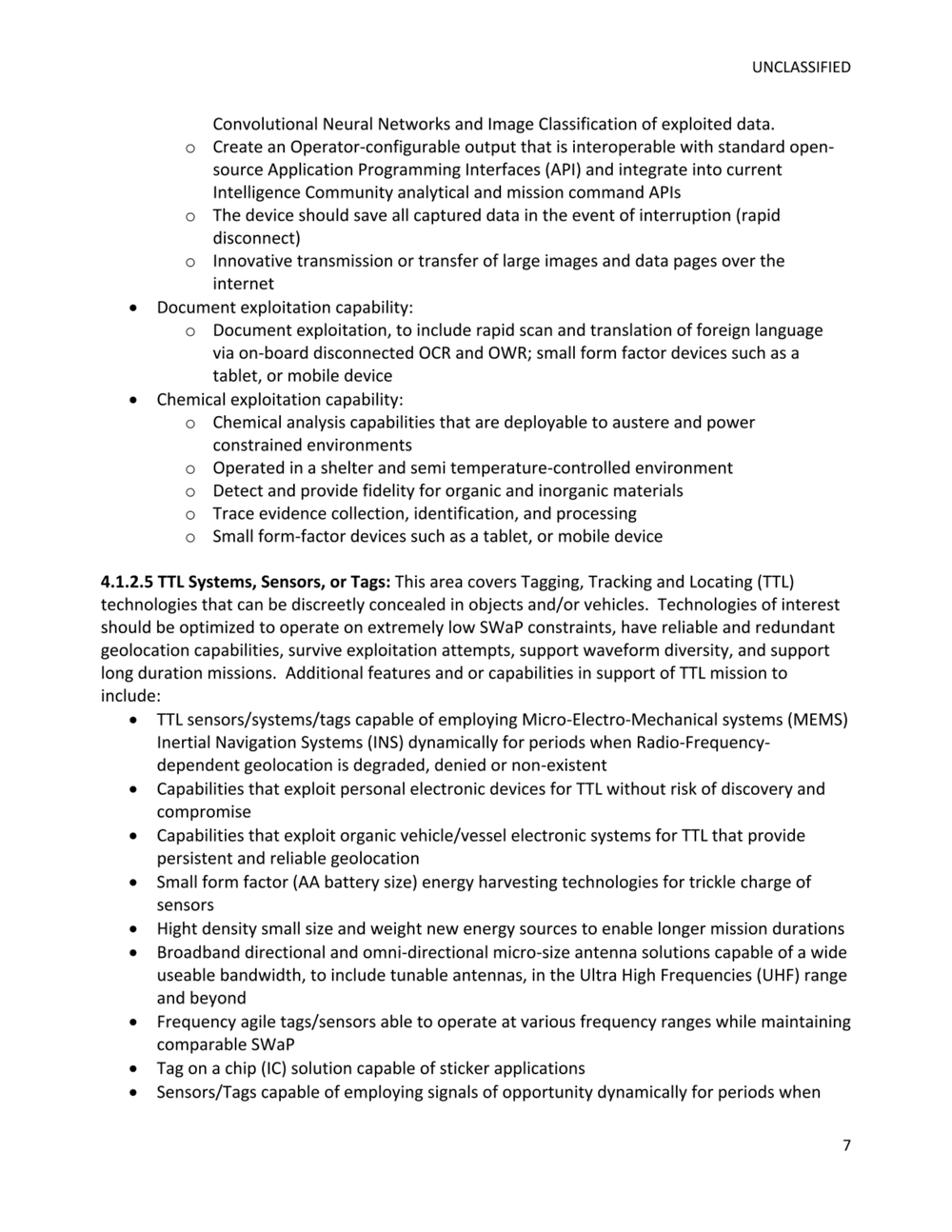
UNCLASSIFIED.
Convolutional Neural Networks and Image Classification of exploited data.
© Create an Operator-configurable output that s interoperable with standard open-
source Application Programming Interfaces (API) and integrate into current
Intelligence Community analytical and mission command APls
© The device should save all captured data in the event of interruption (rapid
disconnect)
© Innovative transmission or transfer of large images and data pages over the
internet
«Document exploitation capability:
© Document exploitation, to include rapid scan and translation of foreign language
via on-board disconnected OCR and OWR; smal form factor devices such as a
tablet, or mobile device
«Chemical exploitation capability:
© Chemical analysis capabilities that are deployable to austere and power
constrained environments
© Operated in a shelter and semi temperature-controlled environment
© Detect and provide fidelity for organic and inorganic materials
© Trace evidence collection, identification, and processing
© small form-factor devices such as a tablet, or mobile device
4.1.2.5 TTL Systems, Sensors, or Tags: This area covers Tagging, Tracking and Locating (TTL)
technologies that can be discreetly concealed in objects and/or vehicles. Technologies of interest
should be optimized to operate on extremely low SWaP constraints, have reliable and redundant
geolocation capabilites, survive exploitation attempts, support waveform diversity, and support
long duration missions. Additional features and or capabilites in support of TTL mission to
include:
«TTL sensors/systems/tags capable of employing Micro-Electro-Mechanical systems (MEMS)
Inertial Navigation Systems (INS) dynamically for periods when Radio-Frequency-
dependent geolocation is degraded, denied or non-existent
«Capabilities that exploit personal electronic devices for TTL without risk of discovery and
compromise
«Capabilities that exploit organic vehicle/vessel electronic systems for TTL that provide
persistent and reliable geolocation
«Small form factor (AA battery size) energy harvesting technologies for trickle charge of
sensors
«Hight density small size and weight new energy sources to enable longer mission durations.
«Broadband directional and omni-directional micro-size antenna solutions capable of a wide
useable bandwidth, to include tunable antennas, in the Ultra High Frequencies (UHF) range
and beyond
«Frequency agile tags/sensors able to operate at various frequency ranges while maintaining
comparable SWaP
«Tag ona chip (IC) solution capable of sticker applications
« Sensors/Tags capable of employing signals of opportunity dynamically for periods when
7
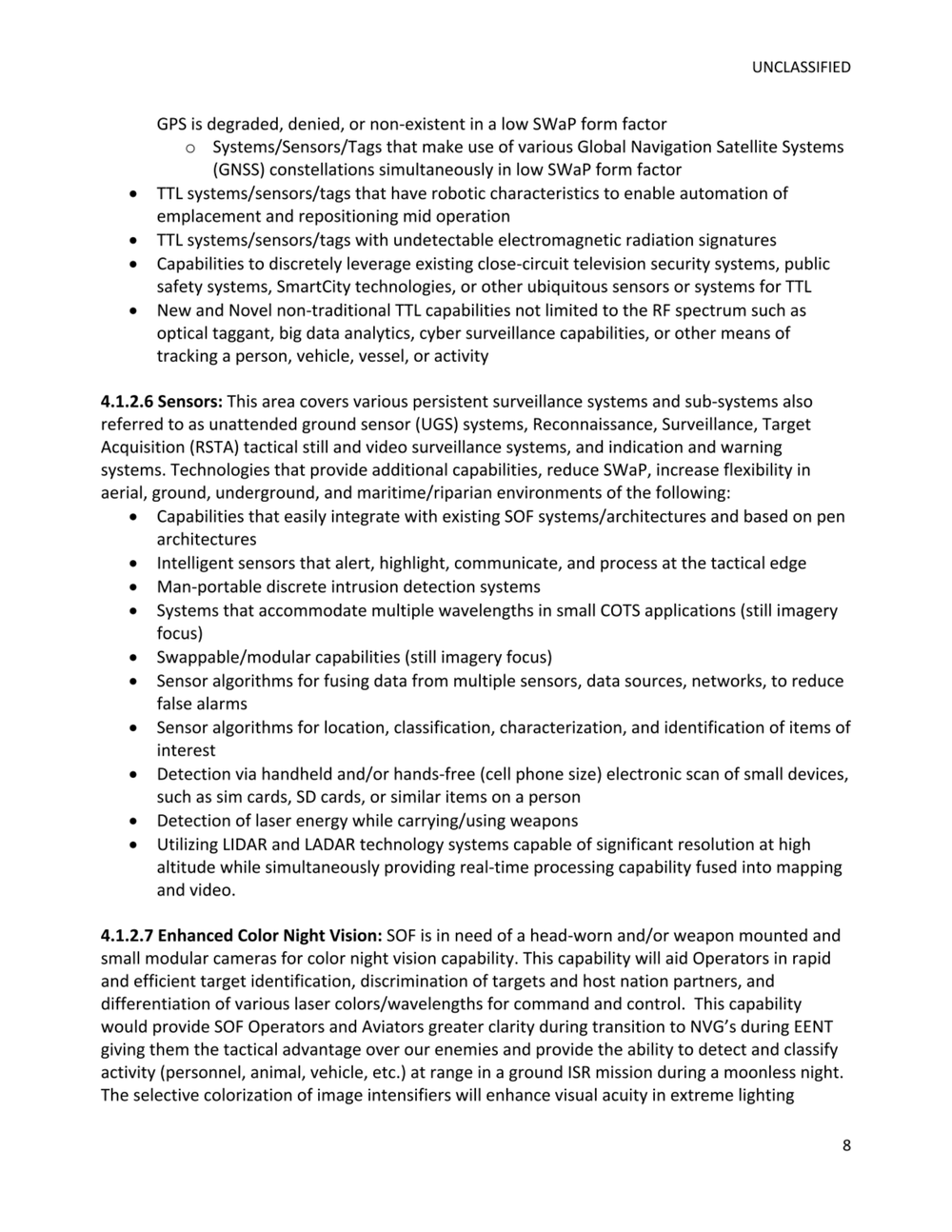
UNCLASSIFIED.
GPS is degraded, denied, or non-existent in a low SWaP form factor
© Systems/Sensors/Tags that make use of various Global Navigation Satellite Systems
(GNSS) constellations simultaneously in low SWaP form factor
«TIL systems/sensors/tags that have robotic characteristics to enable automation of
emplacement and repositioning mid operation
«TL systems/sensors/tags with undetectable electromagnetic radiation signatures
«Capabilities to discretely leverage existing close-circuit television security systems, public
safety systems, SmartCity technologies, or other ubiquitous sensors or systems for TTL
«New and Novel non-traditional TTL capabilities not limited to the RF spectrum such as
optical taggant, big data analytics, cyber surveillance capabilites, or other means of
tracking a person, vehicle, vessel, or activity
4.1.2.6 Sensors: This area covers various persistent surveillance systems and sub-systems also
referred to as unattended ground sensor (UGS) systems, Reconnaissance, Surveillance, Target
Acquisition (RSTA) tactical still and video surveillance systems, and indication and warning
systems. Technologies that provide additional capabilities, reduce SWaP, increase flexibility in
aerial, ground, underground, and maritime/riparian environments of the following:
«Capabilities that easily integrate with existing SOF systems/architectures and based on pen
architectures
«Intelligent sensors that alert, highlight, communicate, and process at the tactical edge
+ Man-portable discrete intrusion detection systems
«Systems that accommodate multiple wavelengths in small COTS applications (stil imagery
focus)
« Swappable/modular capabilities (sill imagery focus)
«Sensor algorithms for fusing data from multiple sensors, data sources, networks, to reduce
false alarms
«Sensor algorithms for location, classification, characterization, and identification of items of
interest
«Detection via handheld and/or hands-free (cell phone size) electronic scan of small devices,
such as sim cards, SD cards, or similar items on a person
«Detection of laser energy while carrying/using weapons
«Utilizing LIDAR and LADAR technology systems capable of significant resolution at high
altitude while simultaneously providing real-time processing capability fused into mapping
and video.
4.1.2.7 Enhanced Color Night Vision: SOF isin need of a head-worn and/or weapon mounted and
small modular cameras for color night vision capability. This capability will aid Operators in rapid
and efficient target identification, discrimination of targets and host nation partners, and
differentiation of various laser colors/wavelengths for command and control. This capability
‘would provide SOF Operators and Aviators greater clarity during transition to NVG's during ENT
giving them the tactical advantage over our enemies and provide the ability to detect and classify
activity (personnel, animal, vehicle, etc.) at range in a ground ISR mission during a moonless night.
The selective colorization of image intensifiers will enhance visual acuity in extreme lighting
8
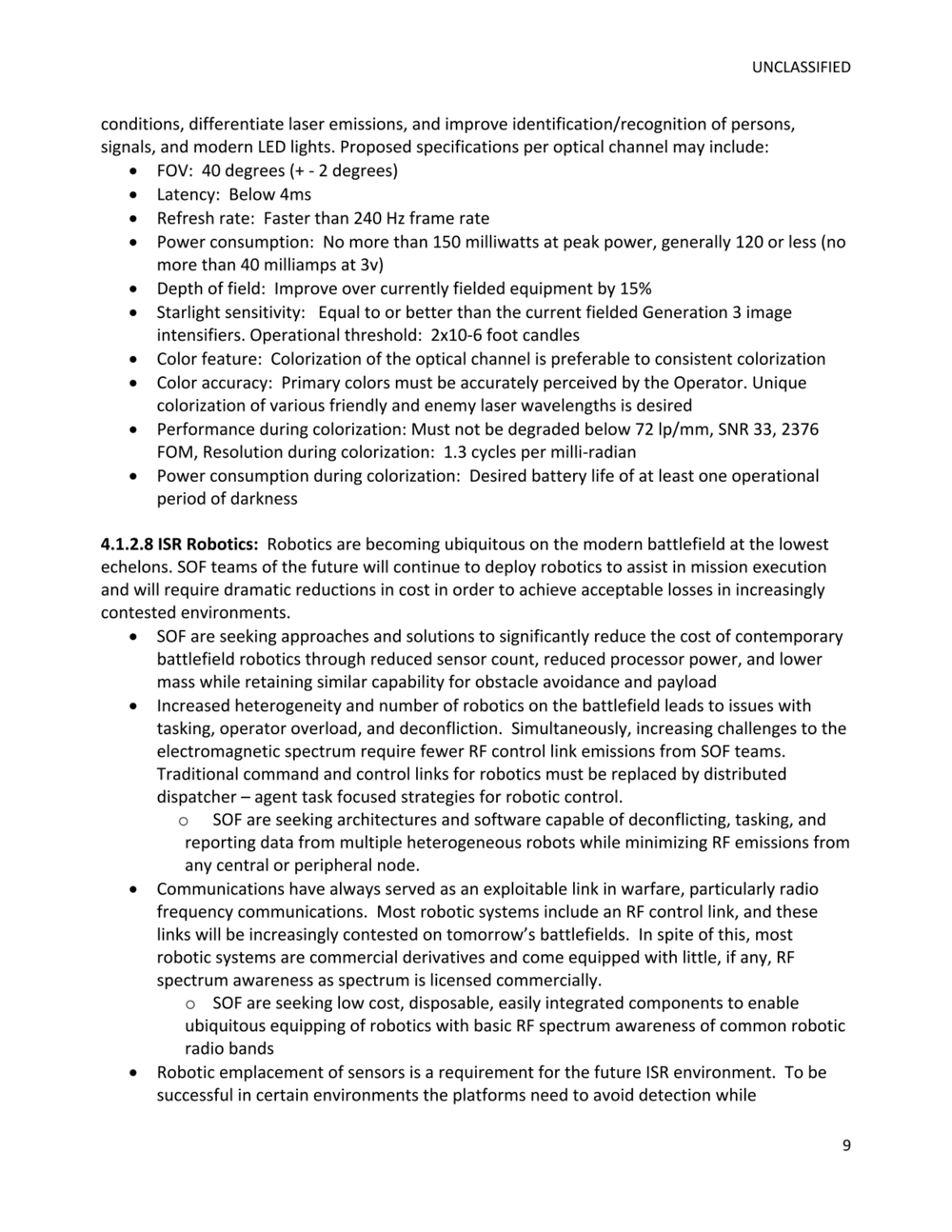
UNCLASSIFIED.
conditions, differentiate laser emissions, and improve identification/recognition of persons,
signals, and modern LED lights. Proposed specifications per optical channel may include:
FOV: 40 degrees (+- 2 degrees)
«Latency: Below 4ms
«Refresh rate: Faster than 240 Hz frame rate
«Power consumption: No more than 150 milliwatts at peak power, generally 120 or less (no.
more than 40 milliamps at 3v)
«Depth of field: Improve over currently fielded equipment by 15%
«Starlight sensitivity: Equal to or better than the current fielded Generation 3 image
intensifiers. Operational threshold: 2x10-6 foot candles
«Color feature: Colorization of the optical channel is preferable to consistent colorization
Color accuracy: Primary colors must be accurately perceived by the Operator. Unique
colorization of various friendly and enemy laser wavelengths s desired
«Performance during colorization: Must not be degraded below 72 lp/mm, SNR 33, 2376
FOM, Resolution during colorization: 1.3 cycles per mill-radian
«Power consumption during colorization: Desired battery life of at least one operational
period of darkness.
4.1.2.8 15R Robotics: Robotics are becoming ubiquitous on the modern battlefield at the lowest
echelons. SOF teams of the future will continue to deploy robotics to assist in mission execution
and will require dramatic reductions in cost in order to achieve acceptable losses in increasingly
contested environments.
«SOF are seeking approaches and solutions to significantly reduce the cost of contemporary
battlefield robotics through reduced sensor count, reduced processor power, and lower
mass while retaining similar capability for obstacle avoidance and payload
«Increased heterogeneity and number of robotics on the battlefield leads to issues with
tasking, operator overload, and deconfliction. Simultaneously, increasing challenges to the
electromagnetic spectrum require fewer RF control link emissions from SOF teams.
Traditional command and control inks for robotics must be replaced by distributed
dispatcher - agent task focused strategies for robotic control.
© SOF are seeking architectures and software capable of deconflicting, tasking, and
reporting data from multiple heterogeneous robots while minimizing RF emissions from
any central or peripheral node.
«Communications have always served as an exploitable link in warfare, particularly radio
frequency communications. Most robotic systems include an RF control ink, and these
links will be increasingly contested on tomorrows battlefields. In spite of this, most
robotic systems are commercial derivatives and come equipped with littl, if any, RF
spectrum awareness as spectrum s licensed commercially.
© SOF are seeking low cost, disposable, easily integrated components to enable
ubiquitous equipping of robotics with basic RF spectrum awareness of common robotic
radio bands
«Robotic emplacement of sensors is a requirement for the future ISR environment. To be
successful in certain environments the platforms need to avoid detection while
9
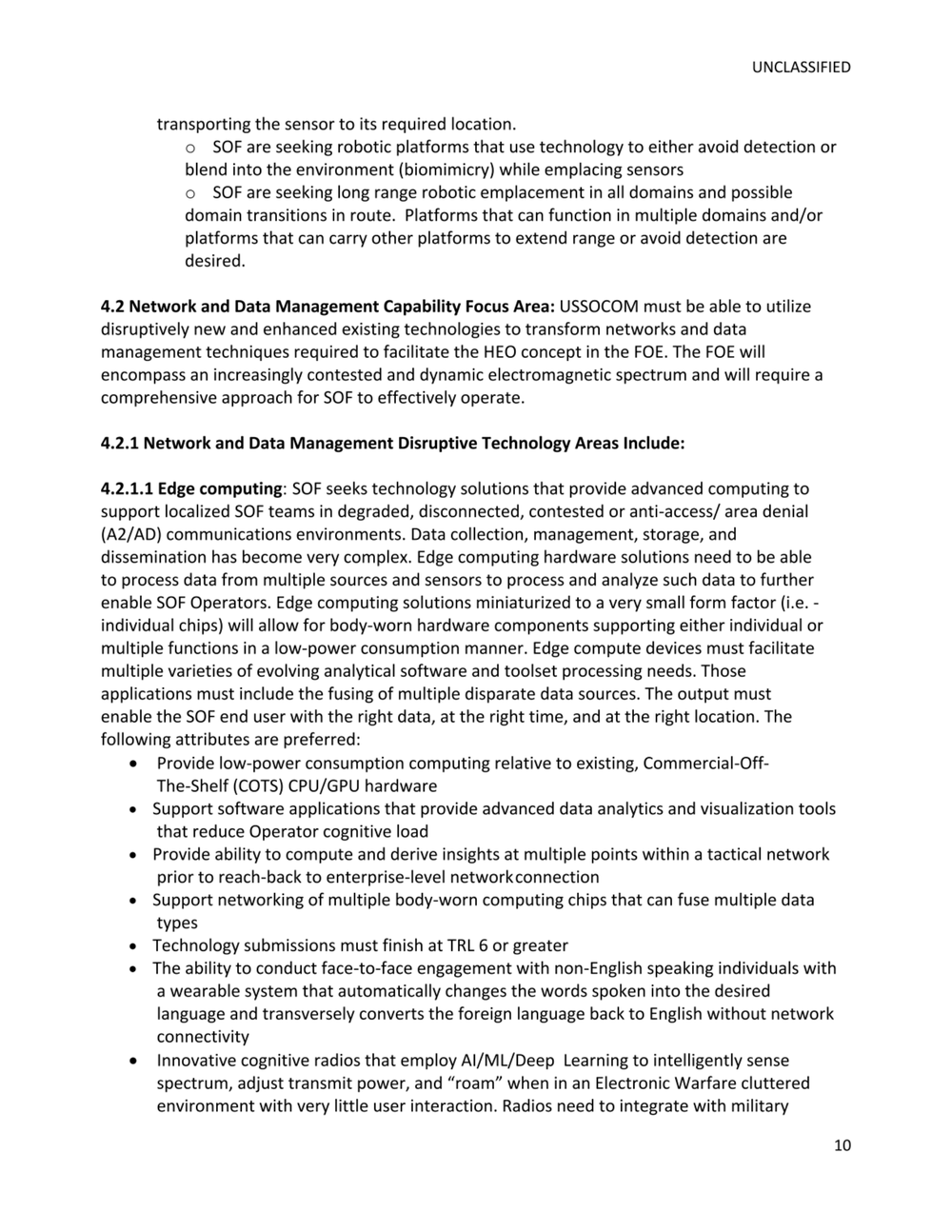
UNCLASSIFIED.
transporting the sensor to its required location.
© SOF are seeking robotic platforms that use technology to either avoid detection or
blend into the environment (biomimicry) while emplacing sensors
© SOF are seeking long range robotic emplacement in all domains and possible
‘domain transitions in route. Platforms that can function in multiple domains and/or
platforms that can carry other platforms to extend range or avoid detection are
desired.
4.2 Network and Data Management Capability Focus Area: USSOCOM must be able to utilize
disruptively new and enhanced existing technologies to transform networks and data
management techniques required to facilitate the HEO concept in the FOE. The FOE will
encompass an increasingly contested and dynamic electromagnetic spectrum and will require a
‘comprehensive approach for SOF to effectively operate.
4.2.1 Network and Data Management Disruptive Technology Areas Include:
4.2.1.1 Edge computing: SOF seeks technology solutions that provide advanced computing to
support localized SOF teams in degraded, disconnected, contested or anti-access/ area denial
(A2/AD) communications environments. Data collection, management, storage, and
dissemination has become very complex. Edge computing hardware solutions need to be able:
to process data from multiple sources and sensors to process and analyze such data to further
enable SOF Operators. Edge computing solutions miniaturized to a very small form factor (i.
individual chips) will allow for body-worn hardware components supporting either individual or
multiple functions in a low-power consumption manner. Edge compute devices must facilitate
multiple varieties of evolving analytical software and toolset processing needs. Those
applications must include the fusing of multiple disparate data sources. The output must
enable the SOF end user with the right data, at the right time, and at the right location. The
following attributes are preferred:
«Provide low-power consumption computing relative to existing, Commercial-Off-
The-Shelf (COTS) CPU/GPU hardware
«support software applications that provide advanced data analytics and visualization tools
that reduce Operator cognitive load
«Provide ability to compute and derive insights at multiple points within a tactical network
prior to reach-back to enterprise-level networkconnection
«support networking of multiple body-worn computing chips that can fuse multiple data
types
«Technology submissions must finish at TRL 6 or greater
«The ability to conduct face-to-face engagement with non-English speaking individuals with
a wearable system that automatically changes the words spoken into the desired
language and transversely converts the foreign language back to English without network
connectivity
«Innovative cognitive radios that employ Al/ML/Deep Learning to intelligently sense
spectrum, adjust transmit power, and “roam” when in an Electronic Warfare cluttered
environment with very little user interaction. Radios need to integrate with military
10

UNCLASSIFIED.
hardware owned and carried by SOF operators. Software should be available as a plugin
or add on as required.
4.2.1.2 Non-Global Positioning Systems (GPS) Positioning, Navigating and Timing: SOF requires
the ability to maintain accurate Position, Navigation and Timing (PNT) in areas where satellite
Global Positioning System (GPS) services and other radio navigation signals are unavailable or
untrusted. Effective navigation and situational awareness in space, in the air, on land or in sea-
based environments are critical to SOF. SOF seeks alternative modalities for achieving Assured
PNT (APNT) services. SOF operates in areas of incidental or deliberate GPS interference or denial.
Incidental denial includes GPS services lost due to movement into subterranean areas (caves,
basements, bunkers) or signal-blocking environments (urban canyon, parking garage, buildings,
and dense urban areas). Deliberate denial includes electromagnetically contested environments.
SOF are interested in countering the proliferation of advanced adversary Global Positioning
System (GPS) jamming and spoofing capabilities. Capabilities should consider a multimodal
approach that combines multiple PNT methods to determine the actual final result. Capabilities
should consider advances in Alternate-PNT devices for mobile platforms that provide options for
distributed networks of cooperative devices such as: celestial attributes, multi-platform-based
beacons/triangulation (SUAS platforms and services), common timing, and the detection of
jammers or other attack vectors. Such capabilities should have cognitive/automated attributes to
assure seamless transition when interruptions or disruptions occur, The following attributes are
preferred
« Solutions must be applicable to multiple platforms including, but not limited to: Maritime,
Fixed Wing, Rotary Wing, tactical vehicles, dismounted forces, and all groups of Unmanned
Aerial Systems (UAS), etc.
« Alternate Timing solutions should consist of the following:
© Rb Oscillator that can hold 1us at 1 week
© Dimensions: 3.65” x5.25" x 2.13" in or smaller, small is preferred
Weight (& 3%) 3.72 Ibs. Less weight is preferred
© Power (Steady State @ 25°C) 20W
© Digital Adjustment Resolution (RAFS-C) $1.06-15
© Operating Temperature (at Baseplate): -20 to +60 °C
© Storage Temperature Range -40 to +75 °C
« Solution accuracy must be equal to or greater than the following
© Position error (xy) < 1% distance travelled
© Position error (2) < 2% distance travelled
© Heading error < 20 degrees/hr
« Technology submissions must finish at TRL 6 or greater
4.2.1.3 Cyber Defense Effects:
4.2.1.3.1 Security at the Edge: The operational SOF environment requires edge computing
devices prioritizing fight-thru capabilities, where functionality, connectivity, and security are all
essential. Edge computing devices can take any form and endpoints are everywhere due to the
1
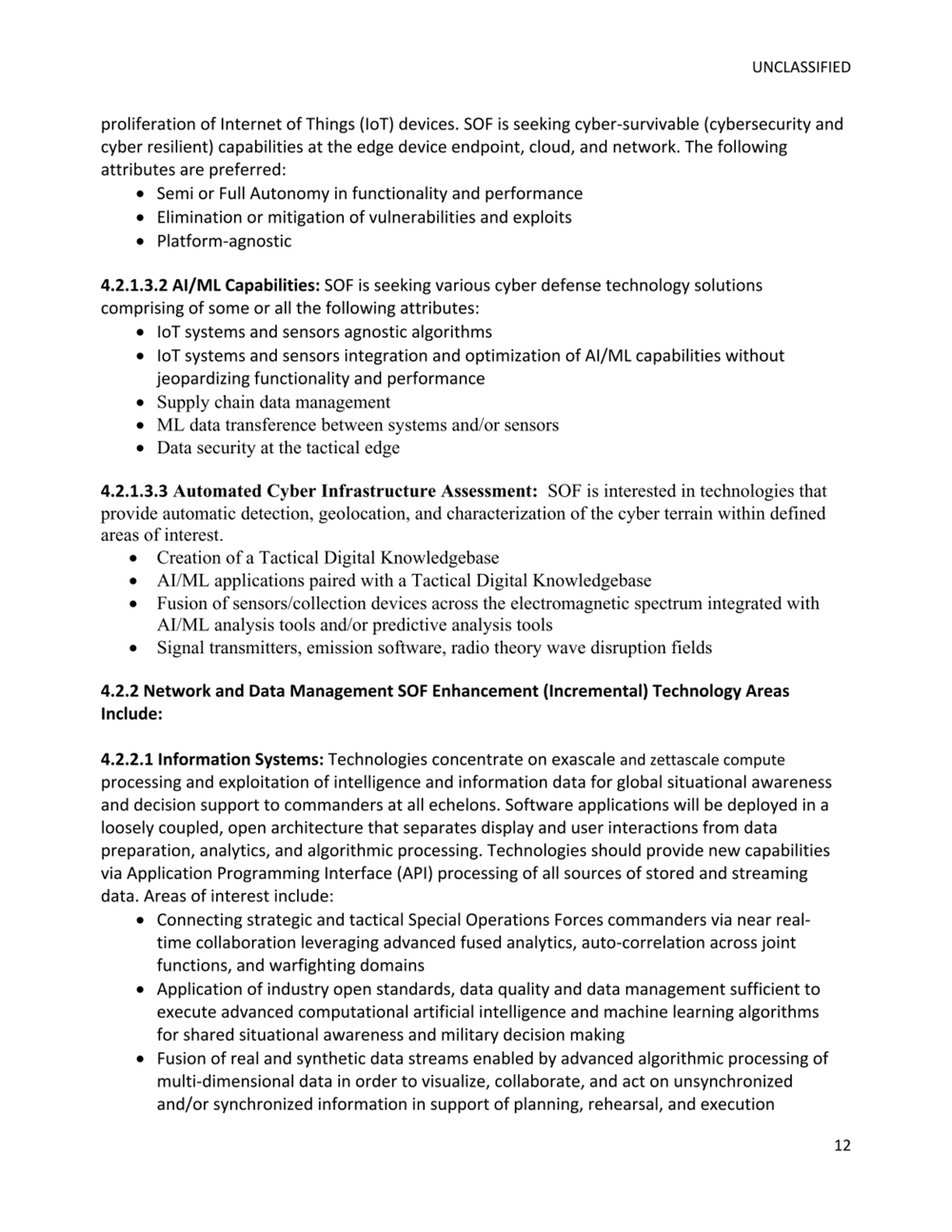
UNCLASSIFIED.
proliferation of Internet of Things (10T) devices. SOF is seeking cyber-survivable (cybersecurity and
cyber resilient) capabilites at the edge device endpoint, cloud, and network. The following
attributes are preferred:
Semi or Full Autonomy in functionality and performance
« Elimination or mitigation of vulnerabilities and exploits
« Platform-agnostic
4.2.1.3.2 AI/ML Capabilities: SOF is seeking various cyber defense technology solutions
‘comprising of some or all the following attributes:
* I0T systems and sensors agnostic algorithms.
« Io systems and sensors integration and optimization of Al/ML capabilities without
jeopardizing functionality and performance
Supply chain data management
+ ML data transference between systems and/or sensors
Data security at the tactical edge
4.2.1.3.3 Automated Cyber Infrastructure Assessment: SOF is interested in technologies that
provide automatic detection, geolocation, and characterization of the cyber terrain within defined
areas of interest.
«Creation of a Tactical Digital Knowledgebase
« AUML applications paired with a Tactical Digital Knowledgebase
«Fusion of sensors/collection devices across the electromagnetic spectrum integrated with
AUML analysis tools and/or predictive analysis tools
«Signal transmitters, emission software, radio theory wave disruption fields
4.2.2 Network and Data Management SOF Enhancement (Incremental) Technology Areas
Include:
4.22.1 Information Systems: Technologies concentrate on exascale and zettascale compute:
processing and exploitation of intelligence and information data for global situational awareness
and decision support to commanders at all echelons. Software applications will be deployed in a
loosely coupled, open architecture that separates display and user interactions from data
preparation, analytics, and algorithmic processing, Technologies should provide new capabilities
via Application Programming Interface (API) processing of all sources of stored and streaming
data. Areas of interest include:
Connecting strategic and tactical Special Operations Forces commanders via near real-
time collaboration leveraging advanced fused analytics, auto-correlation across joint
functions, and warfighting domains
« Application of industry open standards, data quality and data management sufficient to
execute advanced computational artificial intelligence and machine learning algorithms
for shared situational awareness and military decision making
«Fusion of real and synthetic data streams enabled by advanced algorithmic processing of
multi-dimensional data in order to visualize, collaborate, and act on unsynchronized
and/or synchronized information in support of planning, rehearsal, and execution
2
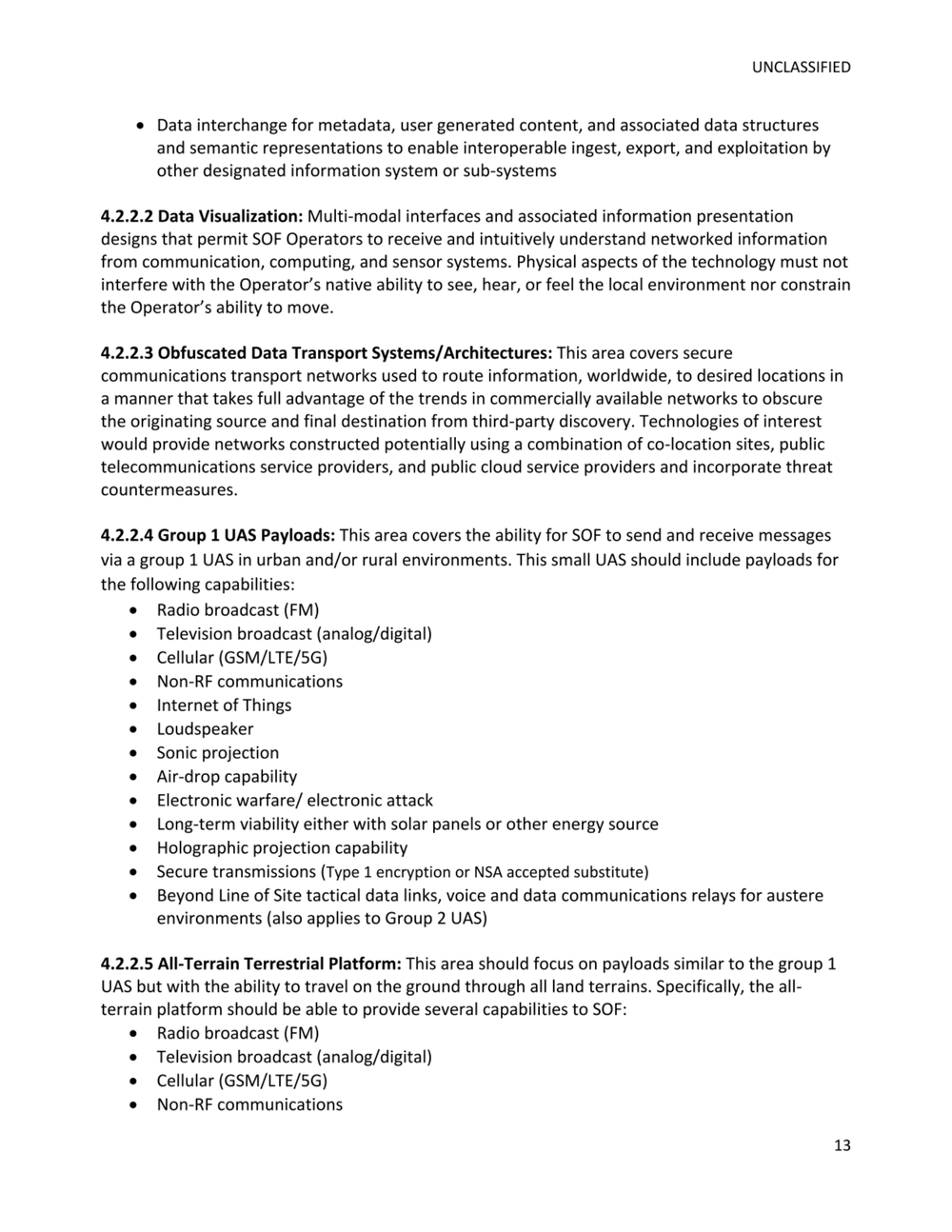
UNCLASSIFIED.
« Data interchange for metadata, user generated content, and associated data structures.
and semantic representations to enable interoperable ingest, export, and exploitation by.
other designated information system or sub-systems
4.2.2.2 Data Visualization: Multi-modal interfaces and associated information presentation
designs that permit SOF Operators to receive and intuitively understand networked information
from communication, computing, and sensor systems. Physical aspects of the technology must not
interfere with the Operator's native ability to see, hear, or feel the local environment nor constrain
the Operator's ability to move.
4.2.2.3 Obfuscated Data Transport Systems/Architectures: This area covers secure
‘communications transport networks used to route information, worldwide, to desired locations in
a manner that takes full advantage of the trends in commercially available networks to obscure:
the originating source and final destination from third-party discovery. Technologies of interest
‘would provide networks constructed potentially using a combination of co-location sites, public
telecommunications service providers, and public cloud service providers and incorporate threat
countermeasures.
4.2.2.4 Group 1 UAS Payloads: This area covers the ability for SOF to send and receive messages
via a group 1 UAS in urban and/or rural environments. This small UAS should include payloads for
the following capabilities:
* Radio broadcast (FM)
«Television broadcast (analog/digital)
«Cellular (GSM/LTE/SG)
Non-RF communications
«Internet of Things
«Loudspeaker
«Sonic projection
« Air-drop capability
«Electronic warfare/ electronic attack
«Long-term viability either with solar panels or other energy source
«Holographic projection capability
«Secure transmissions (Type 1 encryption or NSA accepted substitute)
«Beyond Line of Site tactical data links, voice and data communications relays for austere
environments (also applies to Group 2 UAS)
4.22.5 All-Terrain Terrestrial Platform: This area should focus on payloads similar to the group 1
UAS but with the ability to travel on the ground through all land terrains. Specifically, the all-
terrain platform should be able to provide several capabilities to SOF
* Radio broadcast (FM)
«Television broadcast (analog/digital)
«Cellular (GSM/LTE/S6)
Non-RF communications
13
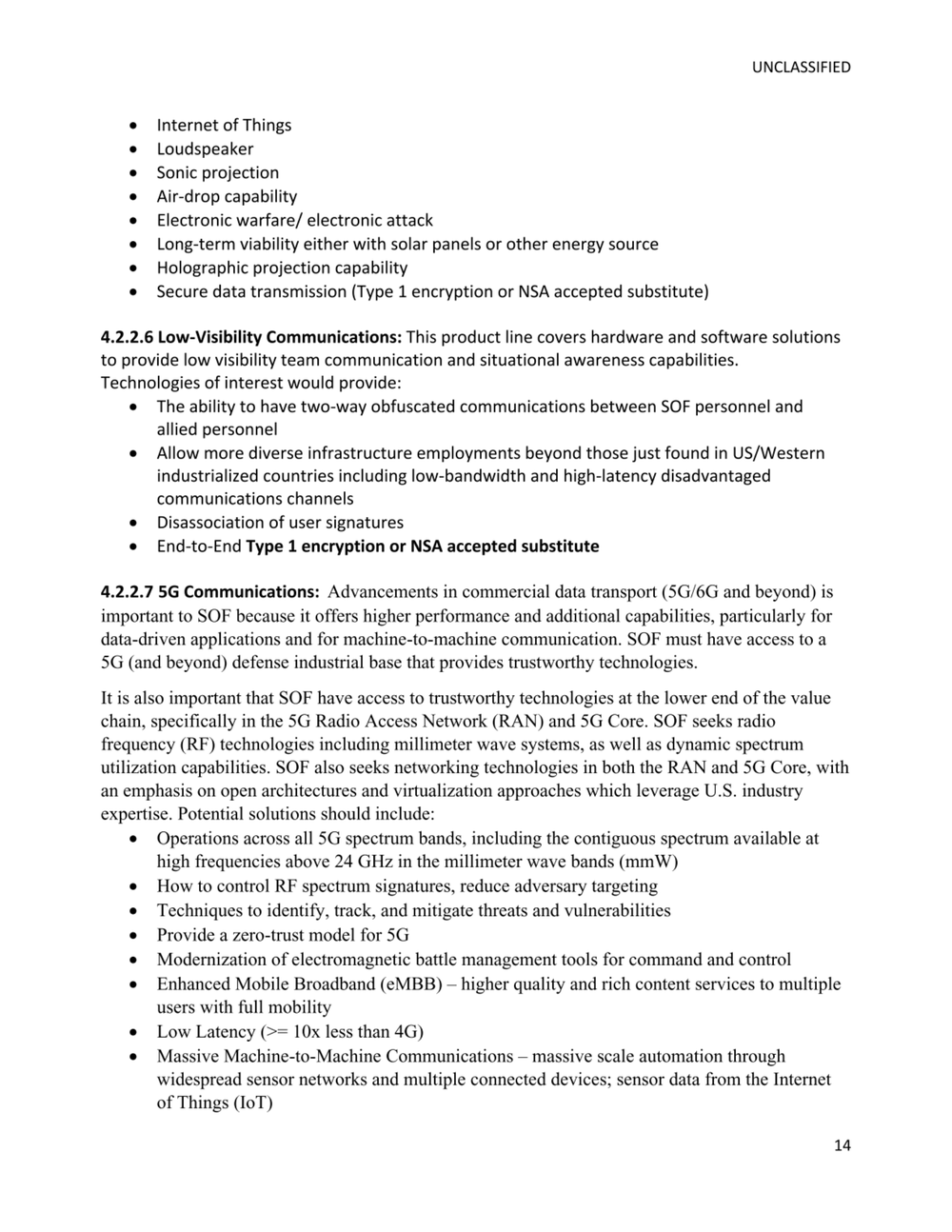
UNCLASSIFIED.
«Internet of Things
«Loudspeaker
«Sonic projection
« Air-drop capability
«Electronic warfare/ electronic attack
«Long-term viability either with solar panels or other energy source
«Holographic projection capability
«Secure data transmission (Type 1 encryption or NSA accepted substitute)
4.2.2.6 Low-Visibility Communications: This product line covers hardware and software solutions
to provide low visibility team communication and situational awareness capabilities.
Technologies of interest would provide:
«The ability to have two-way obfuscated communications between SOF personnel and
allied personnel
«Allow more diverse infrastructure employments beyond those just found in US/Western
industrialized countries including low-bandwidth and high-latency disadvantaged
communications channels
« Disassociation of user signatures.
«End-to-End Type 1 encryption or NSA accepted substitute
4.2.2.7 56 Communications: Advancements in commercial data transport (SG/6G and beyond) is
important to SOF because it offers higher performance and additional capabilities, particularly for
data-driven applications and for machine-to-machine communication. SOF must have access to a
5G (and beyond) defense industrial base that provides trustworthy technologies.
Itis also important that SOF have access to trustworthy technologies at the lower end of the value
chain, specifically in the SG Radio Access Network (RAN) and SG Core. SOF seeks radio
frequency (RF) technologies including millimeter wave systems, as well as dynamic spectrum
utilization capabilities. SOF also seeks networking technologies in both the RAN and 5G Core, with
‘an emphasis on open architectures and virtualization approaches which leverage U.S. industry
expertise. Potential solutions should include:
«Operations across all SG spectrum bands, including the contiguous spectrum available at
high frequencies above 24 GHz in the millimeter wave bands (mmW)
How to control RF spectrum signatures, reduce adversary targeting
«Techniques to identify, track, and mitigate threats and vulnerabilities
«Provide a zero-trust model for SG
Modemization of electromagnetic battle management tools for command and control
«Enhanced Mobile Broadband (MBB) — higher quality and rich content services to multiple
users with full mobility
Low Latency (>= 10x less than 4G)
«Massive Machine-to-Machine Communications — massive scale automation through
widespread sensor networks and multiple connected devices: sensor data from the Internet
of Things (1oT)
14
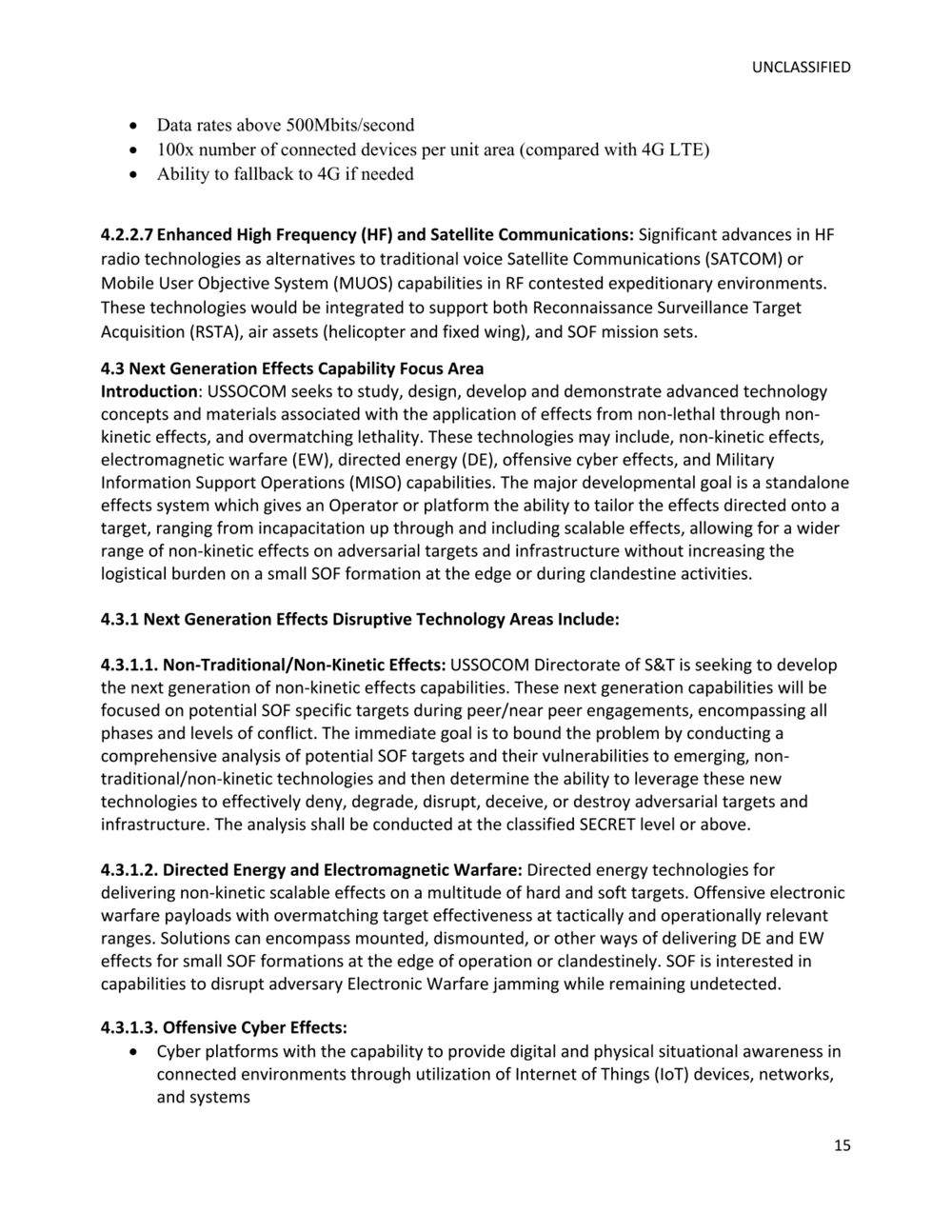
UNCLASSIFIED.
«Data rates above S00Mbits/second
100x number of connected devices per unit area (compared with 4G LTE)
«Ability to fallback to 4G if needed
4.2.2.7 Enhanced High Frequency (HF) and Satellite Communications: Significant advances in HF
radio technologies as alternatives to traditional voice Satellite Communications (SATCOM) or
Mobile User Objective System (MUOS) capabilities in RF contested expeditionary environments.
These technologies would be integrated to support both Reconnaissance Surveillance Target
Acquisition (RSTA), air assets (helicopter and fixed wing), and SOF mission sets
4.3 Next Generation Effects Capability Focus Area
Introduction: USSOCOM seeks to study, design, develop and demonstrate advanced technology
concepts and materials associated with the application of effects from non-lethal through non-
Kinetic effects, and overmatching lethality. These technologies may include, non-kinetic effects,
electromagnetic warfare (EW), directed energy (DE), offensive cyber effects, and Military
Information Support Operations (MISO) capabilities. The major developmental goal is a standalone
effects system which gives an Operator or platform the ability to tailor the effects directed onto a
target, ranging from incapacitation up through and including scalable effects, allowing for a wider
range of non-kinetic effects on adversarial targets and infrastructure without increasing the
logistical burden on a small SOF formation at the edge or during clandestine activities.
4.3.1 Next Generation Effects Disruptive Technology Areas Include:
4.3.1.1. Non-Traditional /Non-Kinetic Effects: USSOCOM Directorate of S&T is seeking to develop
the next generation of non-kinetic effects capabilities. These next generation capabilities will be
focused on potential SOF specific targets during peer/near peer engagements, encompassing all
phases and levels of conflict. The immediate goal is to bound the problem by conducting a
comprehensive analysis of potential SOF targets and their vulnerabilities to emerging, non-
traditional/non-Kinetic technologies and then determine the ability to leverage these new
technologies to effectively deny, degrade, disrupt, deceive, or destroy adversarial targets and
infrastructure. The analysis shall be conducted at the classified SECRET level or above.
4.3.1.2. Directed Energy and Electromagnetic Warfare: Directed energy technologies for
delivering non-kinetic scalable effects on a multitude of hard and soft targets. Offensive electronic
‘warfare payloads with overmatching target effectiveness at tactically and operationally relevant
ranges. Solutions can encompass mounted, dismounted, or other ways of delivering DE and EW.
effects for small SOF formations at the edge of operation or clandestinely. SOF s interested in
capabilities to disrupt adversary Electronic Warfare jamming while remaining undetected.
4.3.1.3. Offensive Cyber Effects:
«Cyber platforms with the capability to provide digital and physical situational awareness in
connected environments through utilization of Internet of Things (IoT) devices, networks,
and systems
15
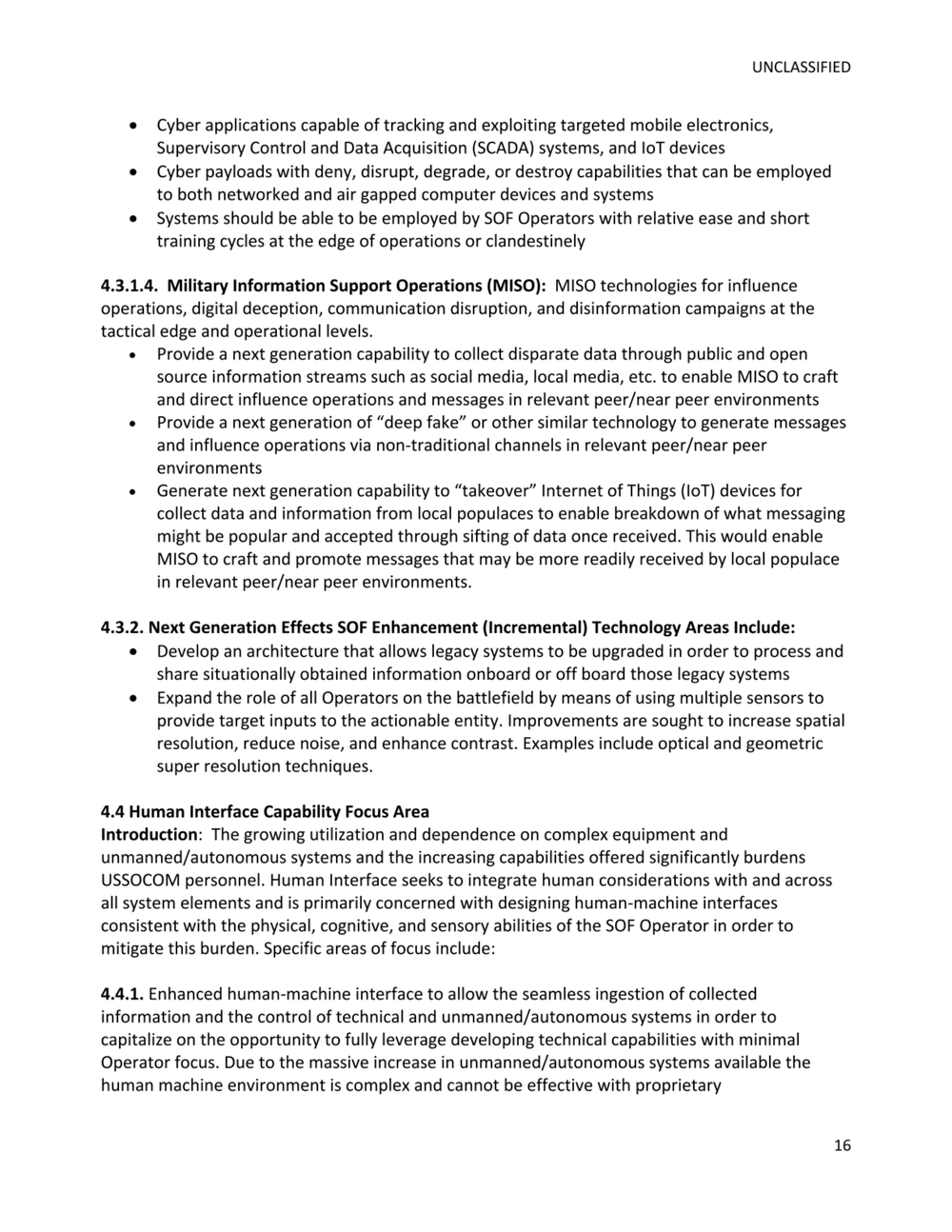
UNCLASSIFIED.
«Cyber applications capable of tracking and exploiting targeted mobile electronics,
Supervisory Control and Data Acquisition (SCADA) systems, and loT devices,
«Cyber payloads with deny, disrupt, degrade, or destroy capabilities that can be employed
10 both networked and air gapped computer devices and systems
«Systems should be able to be employed by SOF Operators with relative ease and short
training cycles at the edge of operations or clandestinely
4.3.1.4. Military Information Support Operations (MISO): MISO technologies for influence
‘operations, digital deception, communication disruption, and disinformation campaigns at the
tactical edge and operational levels.
+ Provide a next generation capability to collect disparate data through public and open
source information streams such as social media, local media, etc. to enable MISO to craft
and direct influence operations and messages in relevant peer/near peer environments
«Provide a next generation of “deep fake” or other similar technology to generate messages
and influence operations via non-traditional channels in relevant peer/near peer
environments.
«Generate next generation capability to “takeover” Internet of Things (IoT) devices for
collect data and information from local populaces to enable breakdown of what messaging
might be popular and accepted through sifting of data once received. This would enable
MISO to craft and promote messages that may be more readily received by local populace
in relevant peer/near peer environments.
4.3.2. Next Generation Effects SOF Enhancement (Incremental) Technology Areas Include:
«Develop an architecture that allows legacy systems to be upgraded in order to process and
share situationally obtained information onboard or off board those legacy systems
«Expand the role of ll Operators on the battlefield by means of using multiple sensors to
provide target inputs to the actionable entity. Improvements are sought to increase spatial
resolution, reduce noise, and enhance contrast. Examples include optical and geometric
super resolution techniques.
4.4 Human Interface Capability Focus Area
Introduction: The growing utilization and dependence on complex equipment and
unmanned/autonomous systems and the increasing capabilities offered significantly burdens
USSOCOM personnel. Human Interface seeks to integrate human considerations with and across
all system elements and is primarily concerned with designing human-machine interfaces
consistent with the physical, cognitive, and sensory abilities of the SOF Operator in order to
mitigate this burden. Specific areas of focus include:
4.4.1. Enhanced human-machine interface to allow the seamless ingestion of collected
information and the control of technical and unmanned/autonomous systems in order to
capitalize on the opportunity to fully leverage developing technical capabilities with minimal
Operator focus. Due to the massive increase in unmanned/autonomous systems available the
human machine environment is complex and cannot be effective with proprietary
16
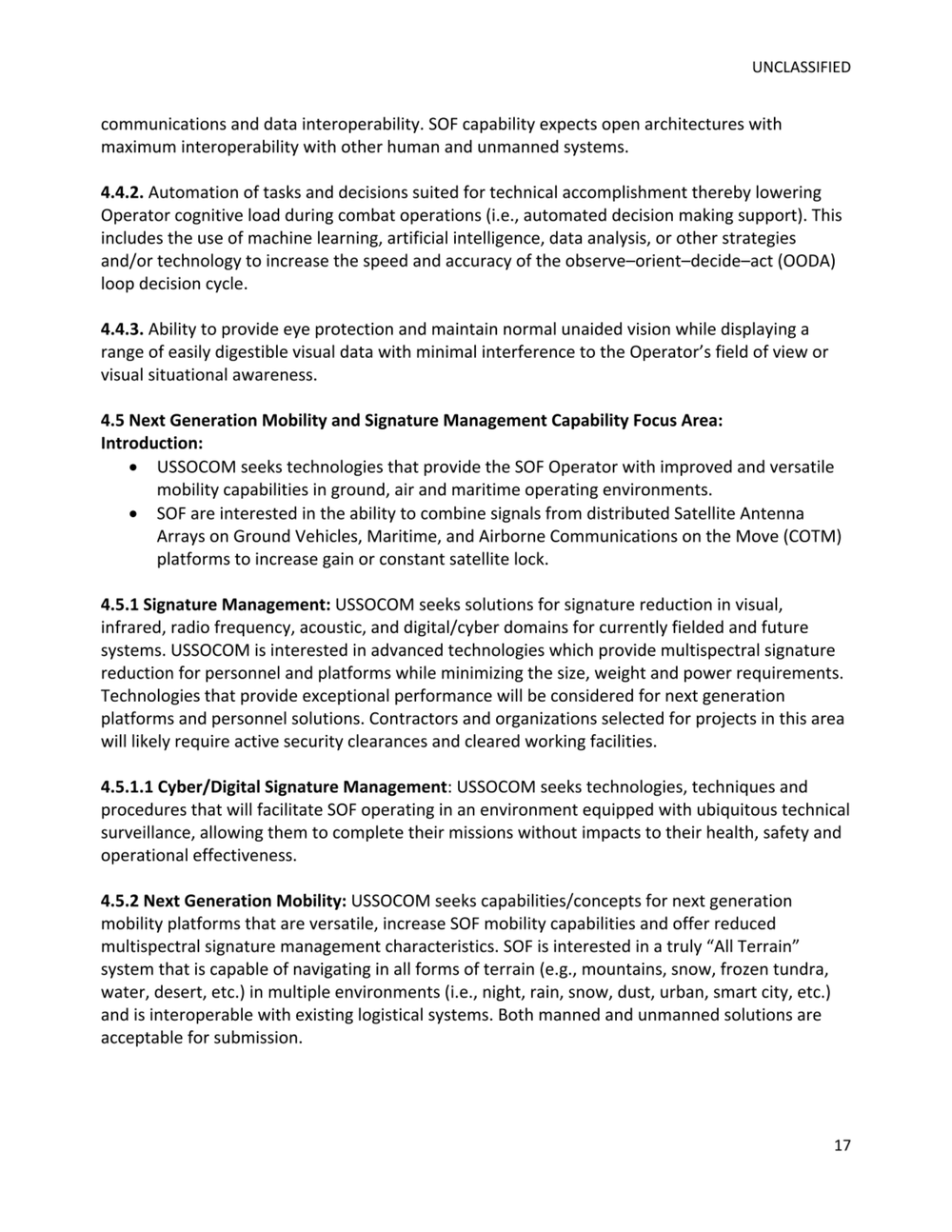
UNCLASSIFIED.
‘communications and data interoperability. SOF capability expects open architectures with
maximum interoperability with other human and unmanned systems.
4.4.2. Automation of tasks and decisions suited for technical accomplishment thereby lowering
Operator cognitive load during combat operations (i.e., automated decision making support). This
includes the use of machine learning, artificial intelligence, data analysis, or other strategies
and/or technology to increase the speed and accuracy of the observe-orient-decide-act (0ODA)
loop decision cycle.
4.4.3. Ability to provide eye protection and maintain normal unaided vision while displaying a
range of easily digestible visual data with minimal interference to the Operator's field of view or
visual situational awareness.
4.5 Next Generation Mobility and Signature Management Capability Focus Area:
Introduction:
+ USSOCOM seeks technologies that provide the SOF Operator with improved and versatile
mobility capabilities in ground, air and maritime operating environments.
SOF are interested in the ability to combine signals from distributed Satellite Antenna
Arrays on Ground Vehicles, Maritime, and Airborne Communications on the Move (COTM)
platforms to increase gain or constant satellite lock.
4.5.1 Signature Management: USSOCOM seeks solutions for signature reduction in visual,
infrared, radio frequency, acoustic, and digital/cyber domains for currently fielded and future
systems, USSOCOM is interested in advanced technologies which provide multispectral signature
reduction for personnel and platforms while minimizing the size, weight and power requirements.
Technologies that provide exceptional performance will be considered for next generation
platforms and personnel solutions. Contractors and organizations selected for projects in this area
will likely require active security clearances and cleared working facilities.
4.5.1.1 Cyber/Digital Signature Management: USSOCOM seeks technologies, techniques and
procedures that wil facilitate SOF operating in an environment equipped with ubiquitous technical
surveillance, allowing them to complete their missions without impacts to their health, safety and
operational effectiveness.
4.5.2 Next Generation Mobility: USSOCOM seeks capabilities/concepts for next generation
mobility platforms that are versatile, increase SOF mobility capabilities and offer reduced
multispectral signature management characteristics. SOF is interested in a truly “All Terrain”
system that is capable of navigating in all forms of terrain (e.g., mountains, snow, frozen tundra,
water, desert, etc.) in multiple environments (i., night, rain, snow, dust, urban, smart city, etc.)
ands interoperable with existing logistical systems. Both manned and unmanned solutions are
acceptable for submission.
7
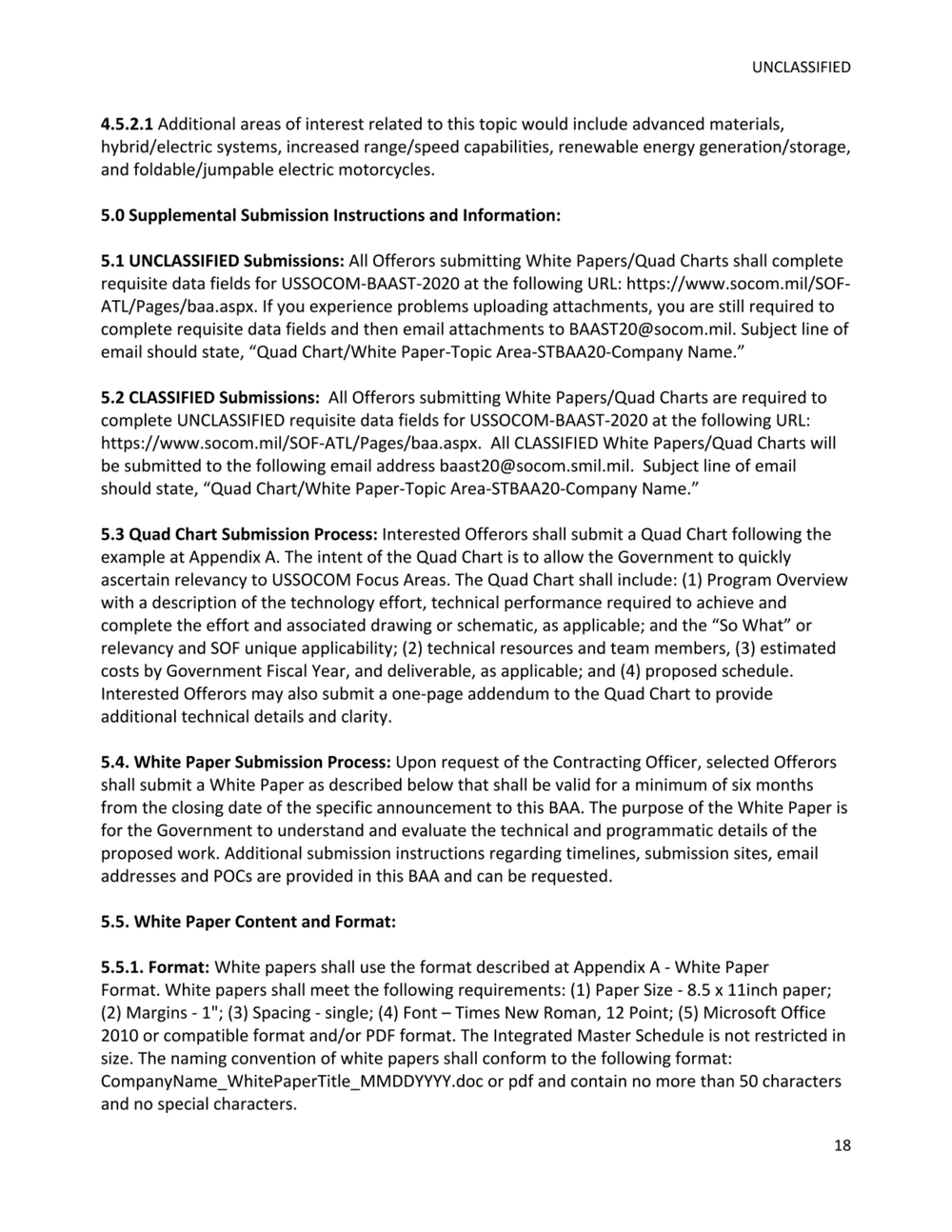
UNCLASSIFIED.
4.5.2.1 Additional areas of interest related to this topic would include advanced materials,
hybrid/electric systems, increased range/speed capabilities, renewable energy generation/storage,
and foldable/jumpable electric motorcycles,
5.0 Supplemental Submission Instructions and Information:
5.1 UNCLASSIFIED Submissions: All Offerors submitting White Papers/Quad Charts shall complete
requisite data fields for USSOCOM-BAAST-2020 at the following URL: https://www.socom.mil/SOF-
ATL/Pages/baa.aspx. If you experience problems uploading attachments, you are still required to
complete requisite data fields and then email attachments to BAAST20@socom.mil. Subject line of
email should state, “Quad Chart/White Paper-Topic Area-STBAA20-Company Name.”
5.2 CLASSIFIED Submissions: Al Offerors submitting White Papers/Quad Charts are required to
‘complete UNCLASSIFIED requisite data fields for USSOCOM-BAAST-2020 at the following URL:
https://www.socom.mil/SOF-ATL/Pages/baa.aspx. All CLASSIFIED White Papers/Quad Charts will
be submitted to the following email address baast20@socom.smil.mil. Subject line of email
should state, “Quad Chart/White Paper-Topic Area-STBAA20-Company Name.”
5.3 Quad Chart Submission Process: Interested Offerors shall submit a Quad Chart following the
example at Appendix A. The intent of the Quad Chart is to allow the Government to quickly.
ascertain relevancy to USSOCOM Focus Areas. The Quad Chart shall include: (1) Program Overview
with a description of the technology effort, technical performance required to achieve and
complete the effort and associated drawing or schematic, as applicable; and the “So What” or
relevancy and SOF unique applicability; (2) technical resources and team members, (3) estimated
costs by Government Fiscal Year, and deliverable, as applicable; and (4) proposed schedule.
Interested Offerors may also submit a one-page addendum to the Quad Chart to provide
additional technical details and clarity.
5.4. White Paper Submission Process: Upon request of the Contracting Officer, selected Offerors
shall submit a White Paper as described below that shall be valid for a minimum of six months
from the closing date of the specific announcement to this BAA. The purpose of the White Paper is
for the Government to understand and evaluate the technical and programmatic details of the
proposed work. Additional submission instructions regarding timelines, submission sites, email
addresses and POCs are provided in this BAA and can be requested.
5.5. White Paper Content and Format:
5.5.1. Format: White papers shall use the format described at Appendix A - White Paper
Format. White papers shall meet the following requirements: (1) Paper Size - 8.5 x 11inch paper;
(2) Margins - 1"; (3) Spacing - single; (4) Font ~ Times New Roman, 12 Point; (5) Microsoft Office
2010 or compatible format and/or PDF format. The Integrated Master Schedule is not restricted in
size. The naming convention of white papers shall conform to the following format:
CompanyName_WhitePaperTitle_MMDDYYYY.doc or pdf and contain no more than 50 characters
and no special characters.
18
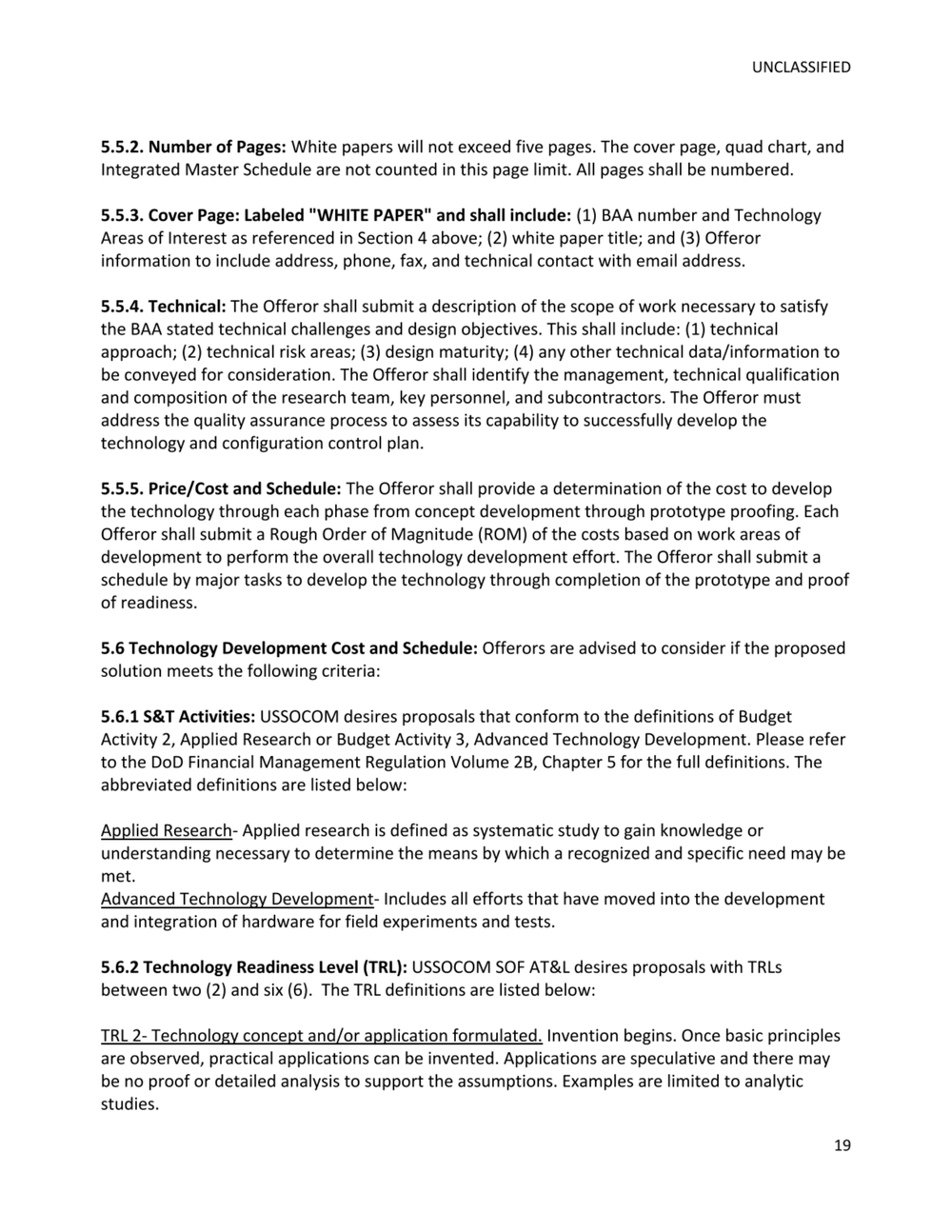
UNCLASSIFIED.
5.5.2. Number of Pages: White papers will not exceed five pages. The cover page, quad chart, and
Integrated Master Schedule are not counted in this page limit. All pages shall be numbered.
5.5.3. Cover Page: Labeled "WHITE PAPER" and shall include: (1) BAA number and Technology
Areas of Interest as referenced in Section 4 above; (2) white paper ttle; and (3) Offeror
information to include address, phone, fax, and technical contact with email address.
5.5.4, Technical: The Offeror shall submit a description of the scope of work necessary to satisfy
the BAA stated technical challenges and design objectives. This shall include: (1) technical
approach; (2) technical risk areas; (3) design maturity; (4) any other technical data/information to
be conveyed for consideration. The Offeror shall identify the management, technical qualification
and composition of the research team, key personnel, and subcontractors. The Offeror must
address the quality assurance process to assess its capability to successfully develop the
technology and configuration control plan.
5.5.5. Price/Cost and Schedule: The Offeror shall provide a determination of the cost to develop.
the technology through each phase from concept development through prototype proofing. Each
Offeror shall submit a Rough Order of Magnitude (ROM) of the costs based on work areas of
development to perform the overall technology development effort. The Offeror shall submit a
schedule by major tasks to develop the technology through completion of the prototype and proof
of readiness.
5.6 Technology Development Cost and Schedule: Offerors are advised to consider if the proposed
solution meets the following criteria:
5.6.1 S&T Activities: USSOCOM desires proposals that conform to the definitions of Budget
Activity 2, Applied Research or Budget Activity 3, Advanced Technology Development. Please refer
to the DoD Financial Management Regulation Volume 28, Chapter 5 for the full definitions. The
abbreviated definitions are listed below:
‘Applied Research- Applied research is defined as systematic study to gain knowledge or
understanding necessary to determine the means by which a recognized and specific need may be
met.
‘Advanced Technology Development- Includes all efforts that have moved into the development
and integration of hardware for field experiments and tests.
5.6.2 Technology Readiness Level (TRL): USSOCOM SOF AT&L desires proposals with TRLS
between two (2) and six (6). The TRL definitions are listed below:
TRL 2- Technology concept and/or application formulated. Invention begins. Once basic principles
are observed, practical applications can be invented. Applications are speculative and there may
be no proof or detailed analysis to support the assumptions. Examples are limited to analytic
studies,
1
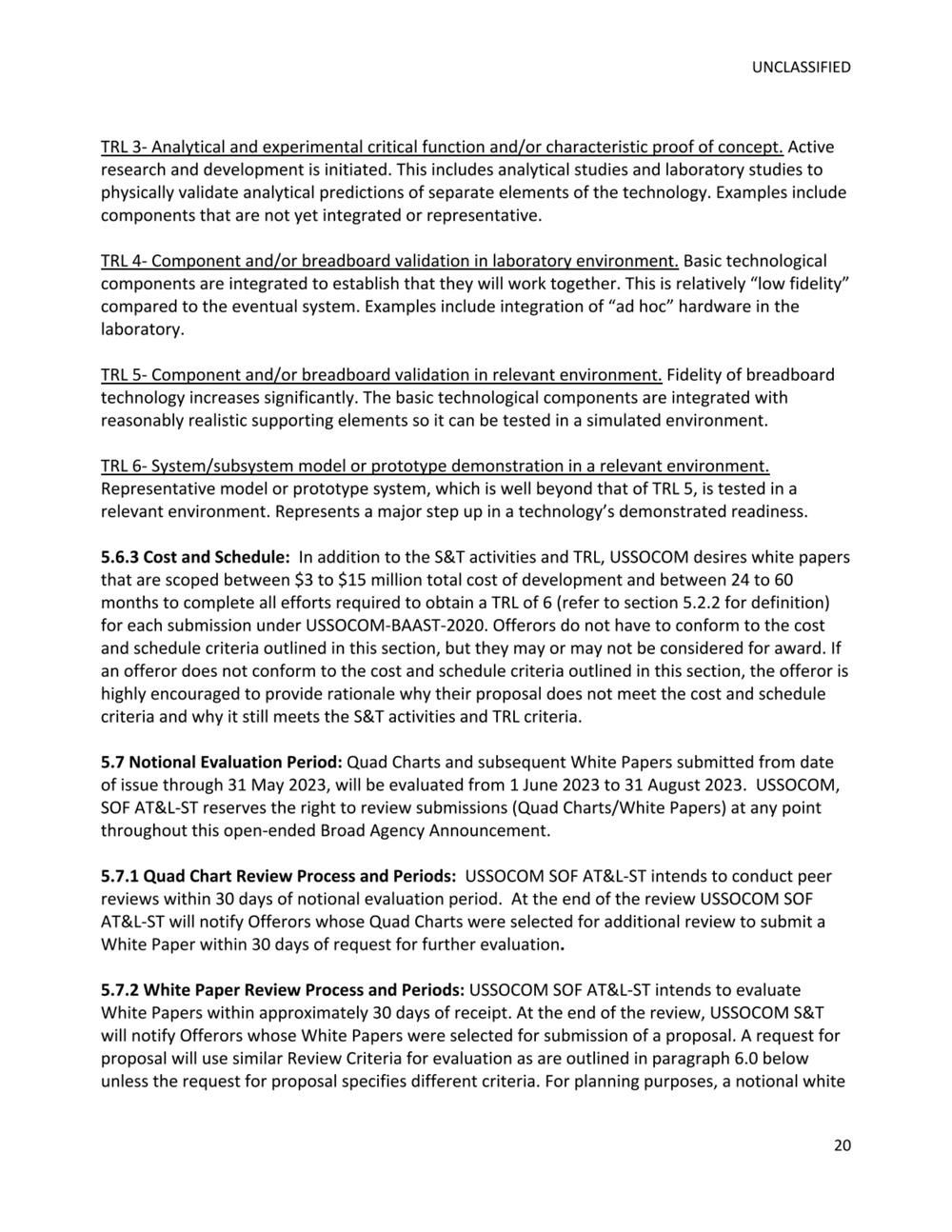
UNCLASSIFIED.
TRL3- Analytical and experimental critical function and/or characteristic proof of concept. Active
research and development is initiated. This includes analytical studies and laboratory studies to
physically validate analytical predictions of separate elements of the technology. Examples include
components that are not yet integrated or representative.
TRL 4- Component and/or breadboard validation in laboratory environment, Basic technological
components are integrated to establish that they will work together. This i relatively “low fidelity”
‘compared to the eventual system. Examples include integration of “ad hoc” hardware in the.
laboratory.
TRL: Component and/or breadboard validation in relevant environment. Fidelity of breadboard
technology increases significantly. The basic technological components are integrated with
reasonably realistic supporting elements so it can be tested in a simulated environment.
TRL 6 System/subsystem model or prototype demonstration in a relevant environment.
Representative model or prototype system, which is well beyond that of TRLS, s tested ina
relevant environment. Represents a major step up in a technology's demonstrated readiness.
5.6.3 Cost and Schedule: In addition to the S&T activities and TRL, USSOCOM desires white papers
that are scoped between $3 to $15 million total cost of development and between 24 to 60
months to complete all efforts required to obtain a TRL of 6 (refer to section 5.2.2 for definition)
for each submission under USSOCOM-BAAST-2020. Offerors do not have to conform to the cost
and schedule criteria outlined in this section, but they may or may not be considered for award. If
an offeror does not conform to the cost and schedule criteria outlined in this section, the offeror is
highly encouraged to provide rationale why their proposal does not meet the cost and schedule
criteria and why it still meets the S&T activites and TRL criteria
5.7 Notional Evaluation Period: Quad Charts and subsequent White Papers submitted from date
of issue through 31 May 2023, wil be evaluated from 1 June 2023 to 31 August 2023. USSOCOM,
SOF AT&L-ST reserves the right to review submissions (Quad Charts/White Papers) at any point
throughout ths open-ended Broad Agency Announcement.
5.7.1 Quad Chart Review Process and Periods: USSOCOM SOF AT&L-ST intends to conduct peer
reviews within 30 days of notional evaluation period. At the end of the review USSOCOM SOF
ATRLST will notify Offerors whose Quad Charts were selected for additional review to submit a
‘White Paper within 30 days of request for further evaluation.
5.7.2 White Paper Review Process and Periods: USSOCOM SOF ATEL-ST intends to evaluate
White Papers within approximately 30 days of receipt. At the end of the review, USSOCOM S&T
will notify Offerors whose White Papers were selected for submission of a proposal. A request for
proposal will use similar Review Criteria for evaluation as are outlined in paragraph 6.0 below
unless the request for proposal specifies different criteria. For planning purposes, a notional white
20
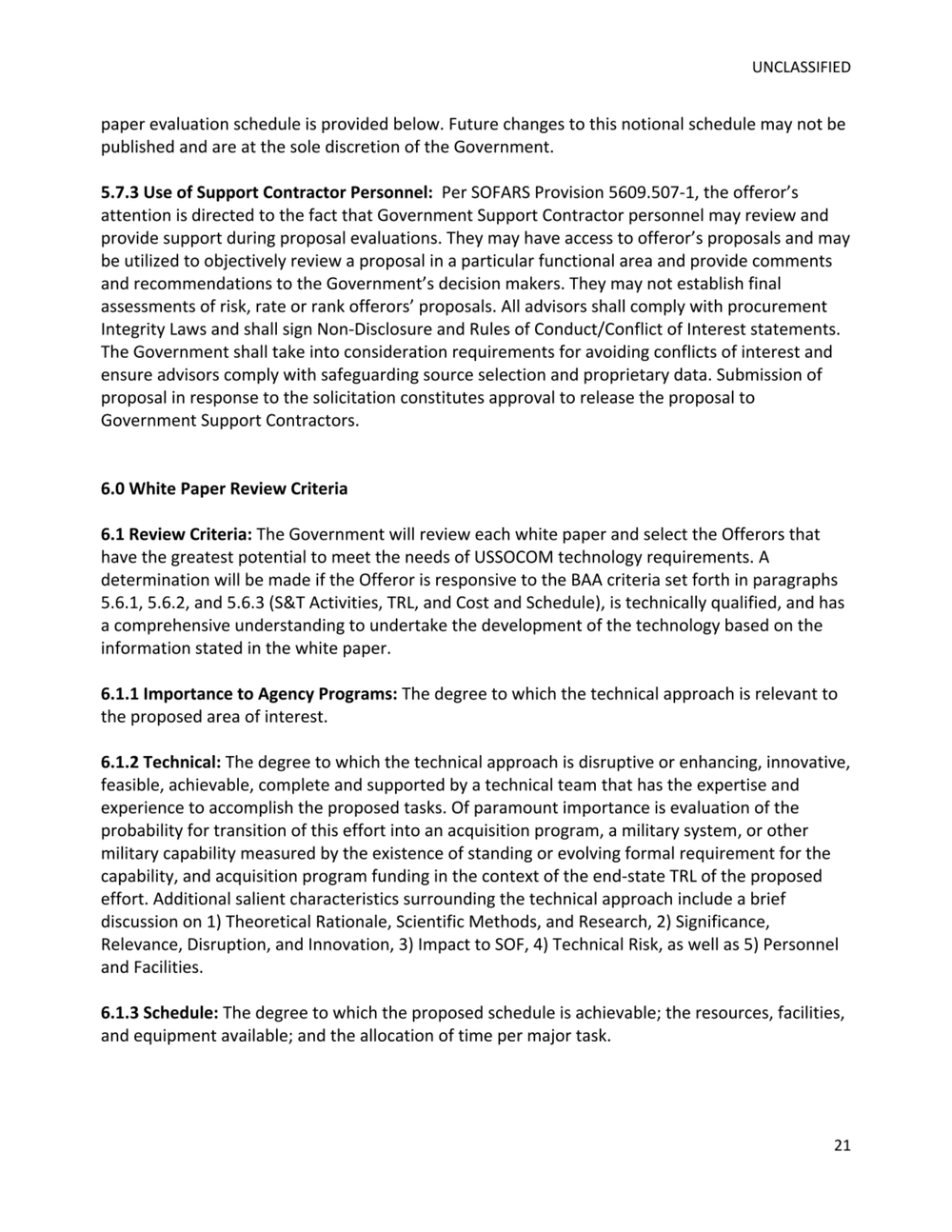
UNCLASSIFIED.
paper evaluation schedule is provided below. Future changes to this notional schedule may not be
published and are at the sole discretion of the Government
5.7.3 Use of Support Contractor Personnel: Per SOFARS Provision 5609.507-1, the offeror’s
attention is directed to the fact that Government Support Contractor personnel may review and
provide support during proposal evaluations. They may have access to offeror’s proposals and may
be utilized to objectively review a proposal in a particular functional area and provide comments
and recommendations to the Government's decision makers. They may not establish final
assessments of risk, rate or rank offerors’ proposals. All advisors shall comply with procurement
Integrity Laws and shall sign Non-Disclosure and Rules of Conduct/Conflict of Interest statements.
The Government shall take into consideration requirements for avoiding conflicts of interest and
ensure advisors comply with safeguarding source selection and proprietary data. Submission of
proposal in response to the solicitation constitutes approval to release the proposal to
Government Support Contractors.
6.0 White Paper Review Criteria
6.1 Review Criteria: The Government will review each white paper and select the Offerors that
have the greatest potential to meet the needs of USSOCOM technology requirements. A
determination will be made if the Offeror is responsive to the BAA criteria set forth in paragraphs
5.6.1,5.62,and 5.6.3 (S&T Activities, TRL, and Cost and Schedule), is technically qualified, and has
a comprehensive understanding to undertake the development of the technology based on the
information stated in the white paper.
6.1.1 Importance to Agency Programs: The degree to which the technical approach is relevant to
the proposed area of interest.
6.1.2 Technical: The degree to which the technical approach is disruptive or enhancing, innovative,
feasible, achievable, complete and supported by a technical team that has the expertise and
experience to accomplish the proposed tasks. Of paramount importance is evaluation of the
probability for transition of this effort into an acquisition program, a military system, or other
military capability measured by the existence of standing or evolving formal requirement for the
capability, and acquisition program funding in the context of the end-state TRL of the proposed
effort. Additional salient characteristics surrounding the technical approach include a brief
discussion on 1) Theoretical Rationale, Scientific Methods, and Research, 2) Significance,
Relevance, Disruption, and Innovation, 3) Impact to SOF, 4) Technical Risk, as well as 5) Personnel
and Facilites.
6.1.3 Schedule: The degree to which the proposed schedule is achievable; the resources, facilities,
and equipment available; and the allocation of time per major task.
21
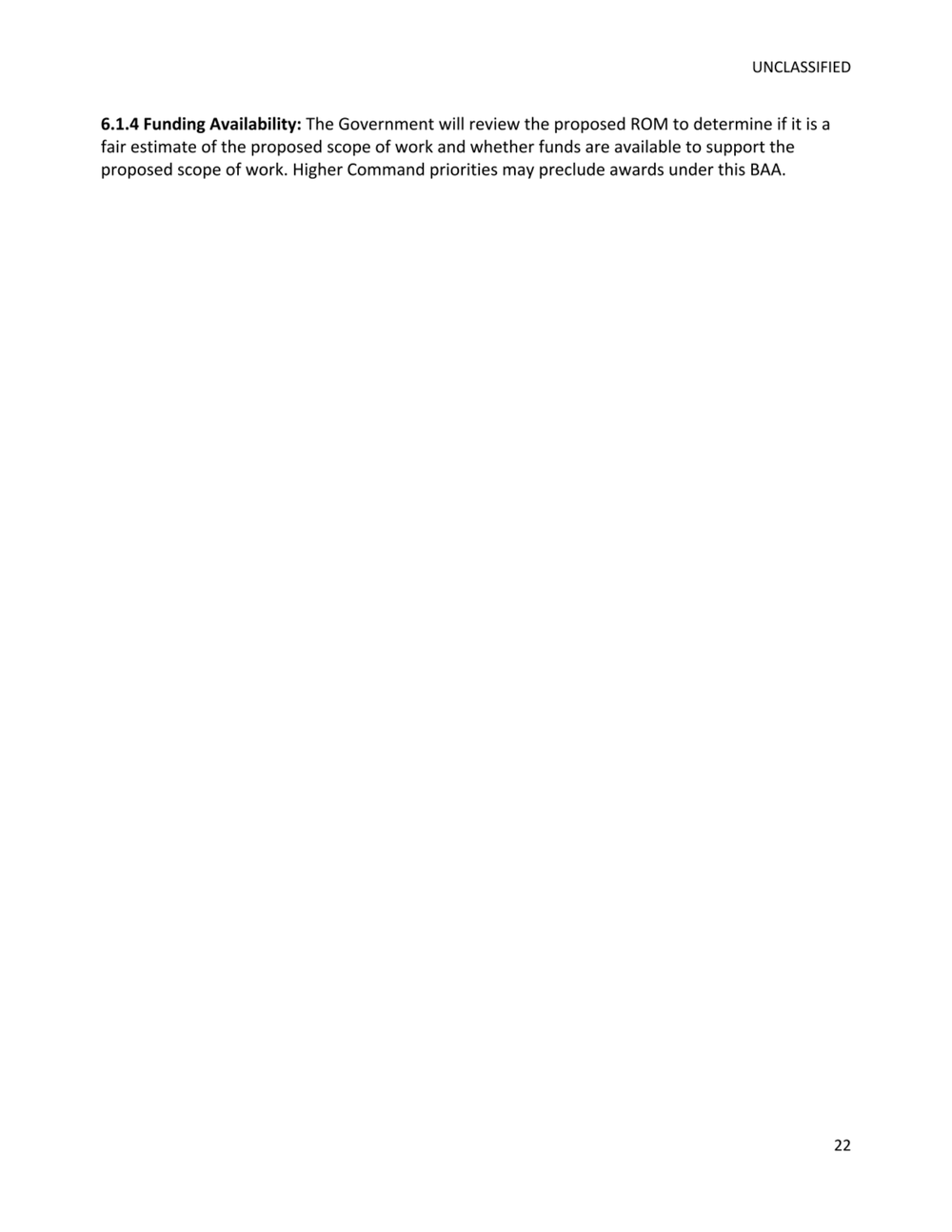
UNCLASSIFIED.
6.1.4 Funding Availability: The Government will review the proposed ROM to determine if itis a
far estimate of the proposed scope of work and whether funds are available to support the
proposed scope of work. Higher Command priorities may preclude awards under this BAA
2
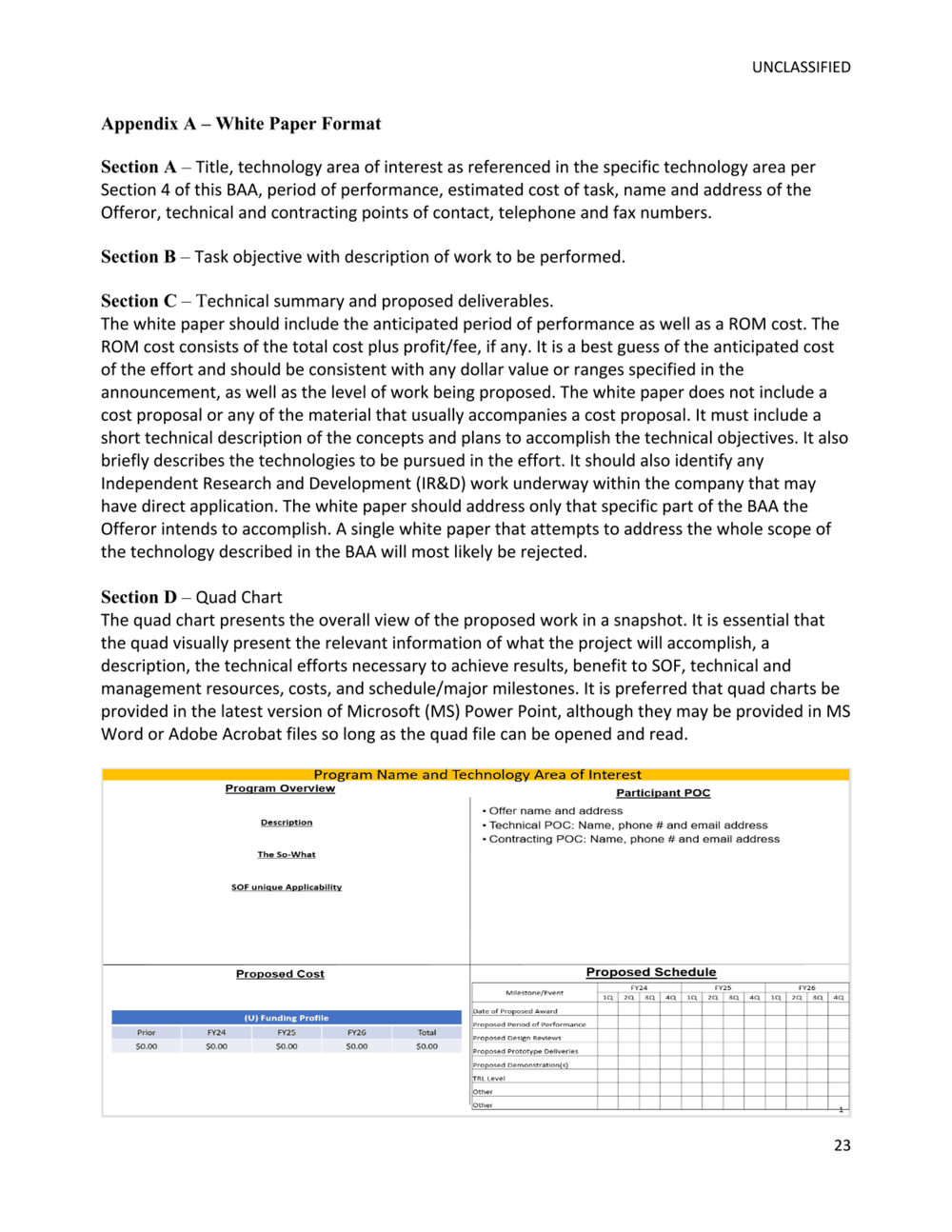
UNCLASSIFIED.
Appendix A — White Paper Format
Section A Title, technology area of interest as referenced in the specific technology area per
Section 4 of this BAA, period of performance, estimated cost of task, name and address of the
Offeror, technical and contracting points of contact, telephone and fax numbers.
Section B Task objective with description of work to be performed
Section C — Technical summary and proposed deliverables.
The white paper should include the anticipated period of performance as well as a ROM cost. The
ROM cost consists of the total cost plus profit/fee, if any. It is a best guess of the anticipated cost
of the effort and should be consistent with any dollar value or ranges specified in the
announcement, as well as the level of work being proposed. The white paper does not include a
cost proposal or any of the material that usually accompanies a cost proposal. It must include a
short technical description of the concepts and plans to accomplish the technical objectives. It also
briefly describes the technologies to be pursued in the effort. It should also identify any
Independent Research and Development (IR&D) work underway within the company that may
have direct application. The white paper should address only that specific part of the BAA the
Offeror intends to accomplish. A single white paper that attempts to address the whole scope of
the technology described in the BAA will most likely be rejected.
Section D — Quad Chart
The quad chart presents the overall view of the proposed work in a snapshot. Itis essential that
the quad visually present the relevant information of what the project will accomplish, a
description, the technical efforts necessary to achieve results, benefit to SOF, technical and
management resources, costs, and schedule/major milestones. Itis preferred that quad charts be
provided in the latest version of Microsoft (MS) Power Point, although they may be provided in MS.
Word or Adobe Acrobat files so long as the quad file can be opened and read.
pra Nae ad Technology AER Gf Interests
eroaram ovaniew “nrHu.1
TT weeds Proposed schedule
7 ©
23